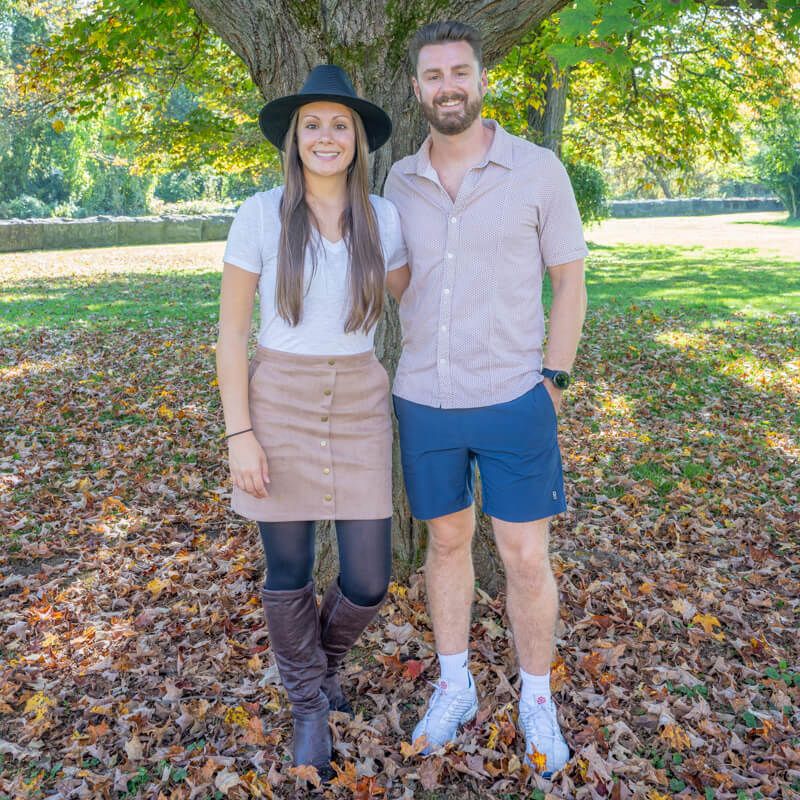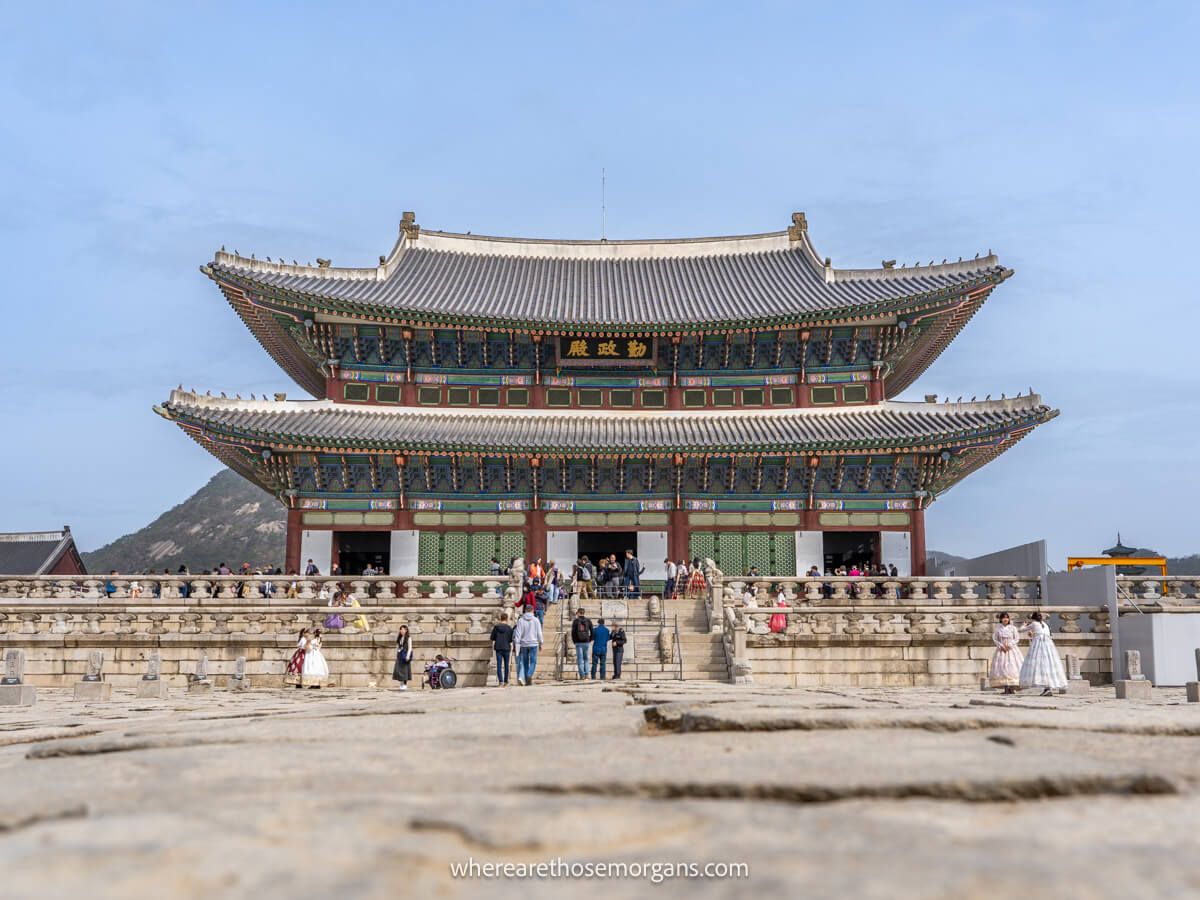Located in northern Seoul, Gyeongbokgung Palace is one of the best things to do in the city. It was built in 1395 and served as main palace during the Joseon Dynasty so it’s a great place to learn about Korean history and traditions.
In this guide, we’re going to show you exactly what to see inside Gyeongbokgung Palace including highlights you should not miss and how to take the free guided tour.
Our Seoul Experience
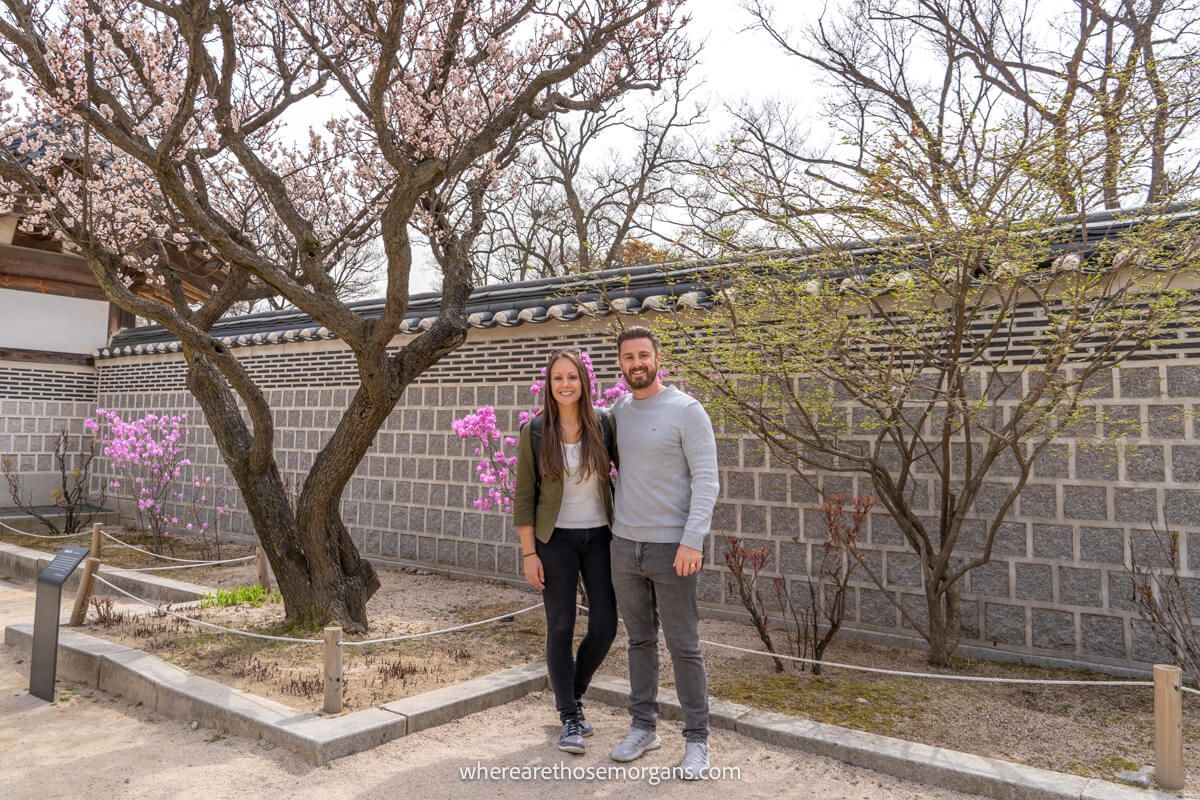
We spent 14 days exploring Seoul in March 2023. During this trip, we personally visited Gyeongbokgung Palace as well as the 4 other royal palaces in Seoul. This is the most popular and well known palace in the city and it was extremely busy, especially because it was the beginning of cherry blossom season.
Since this is the largest palace complex, we decided to take the free guided tour so we could easily see the highlights. Our guide will show you what to expect and how to plan your day to make the most of your time here. Read more about us.
Gyeongbokgung Palace History
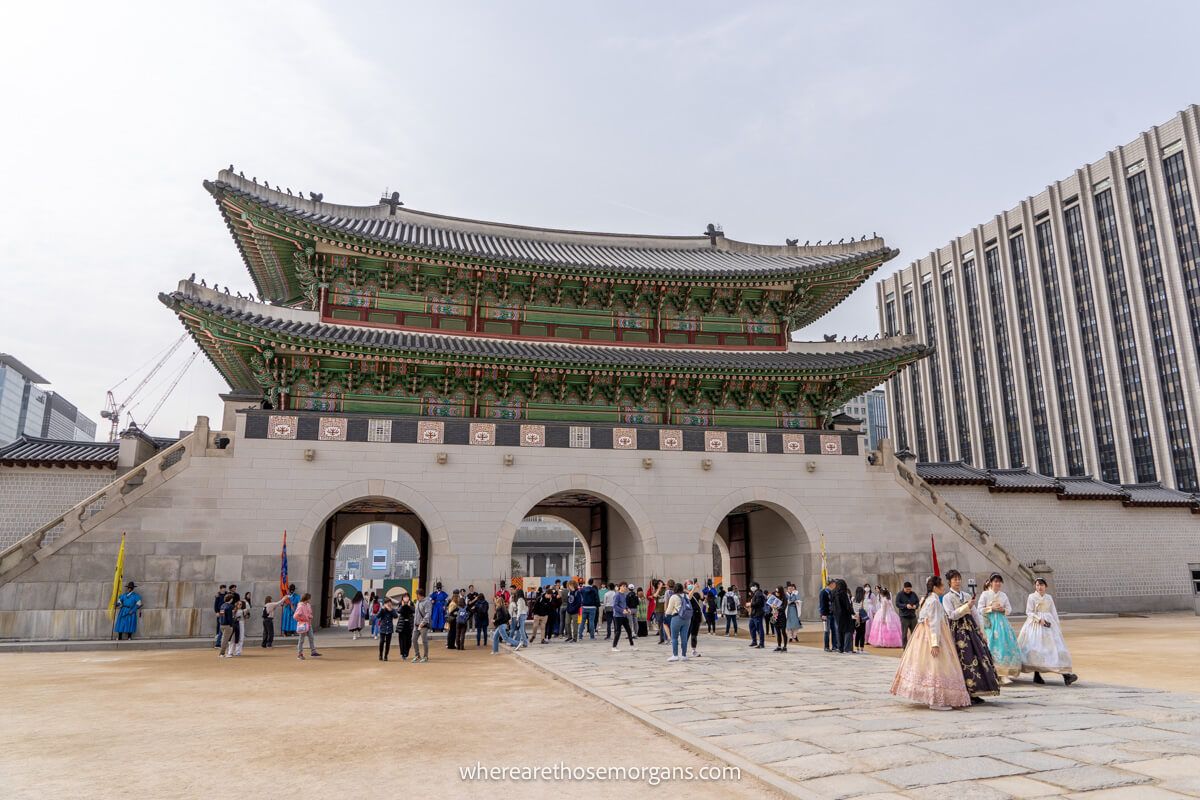
Originally built in 1395, Gyeongbokgung Palace was the primary palace established for the Joseon Dynasty (1932-1910). It was constructed between Baegaksan Mountain to the north and present day Sejong-deoro to the south so it become influential in the dynasty’s economy and politics.
The name “Gyeongbok” translates to brilliance and fortune and it reflected the founders hope for the dynasty to have good fortunes and prosper. Sadly, the palace has been destroyed several times by numerous Japanese invasions with the last occupation occurring from 1910-1945.
However, in 1990 an extensive restoration project demolished the Japanese government building that was constructed over the place grounds and the original buildings have been rebuilt.
Visitor Information
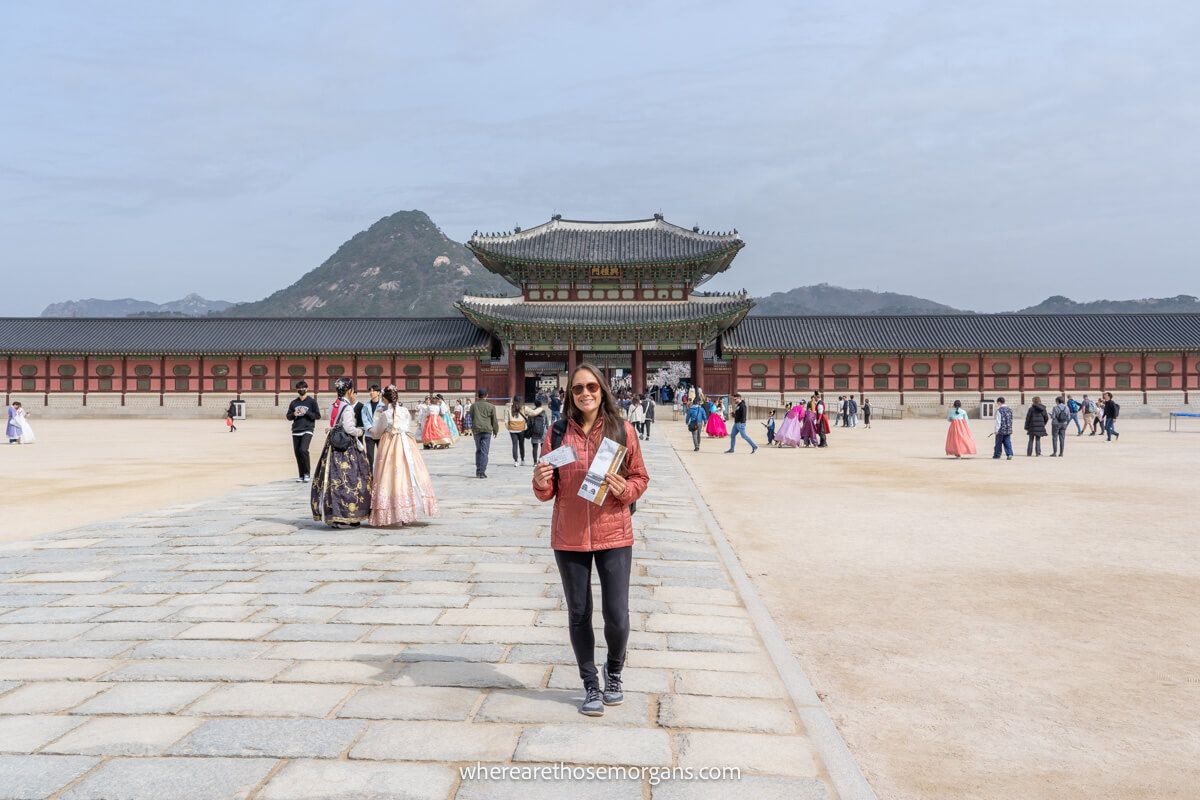
Known as the northern palace, Gyeongbokgung is located in the northern part of the city. It’s open every day of the week from 9:00-17:00 or 18:30 depending on time of year, but it’s closed Tuesday. Last admission is one hour before closing so make sure you give yourself enough time when visiting.
- Address: 161 Sajik-ro, Jongno-gu, Seoul, South Korea
- Location: Google maps
- Best subway stop: Gyeongbokgung Palace Station (line 3, exit 5) or Gwanghwamun Station (line 5, exit 2)
Admission tickets for Gyeongbokgung Palace cost 3,000 KRW for adults (US$ 2.26) and 2,400 KRW (US$ 1.81) with groups of 10 or more. Visitors over the age of 65 and children under the age of 19 will receive free entry into the palace. You can also visit for free on Culture Day, which is the last Wednesday of every month.
We think the easiest way to purchase tickets is on site, but if you plan to visit all 5 of Seoul’s royal palaces, you should consider the royal palace pass. This is what we used to visit Gyeongbokgung Palace.
The royal palace pass costs 10,000 KRW (US $7.53) and it’s valid for three months from the date of purchase. This pass can only be purchased from the sites listed below:
- Gyeongbokgung
- Changdeokgung
- Changgyeonggung
- Deoksugung
- Jongmyo Shrine
It’s a good opportunity for those who want to visit numerous palaces in the city because it will save you a little bit of money. Additionally, it also saved us some time by not having to wait in a long ticket line.
Hanbok Rentals
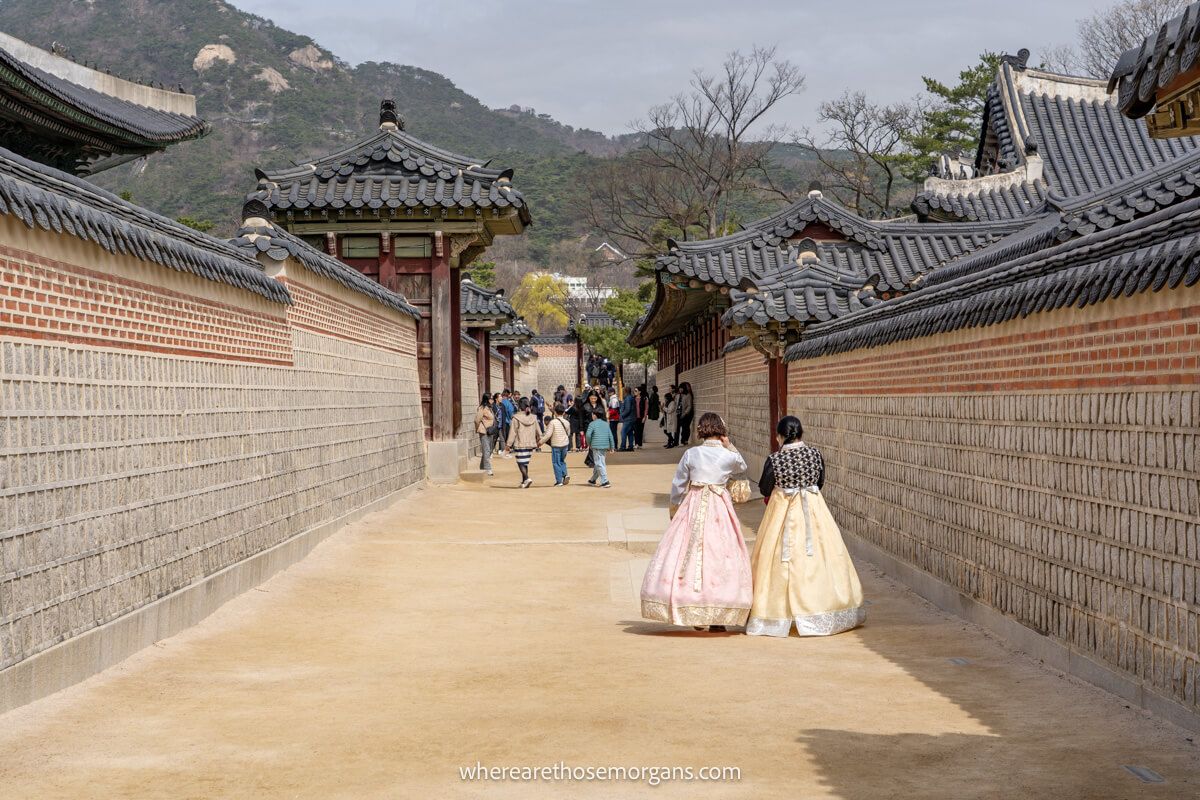
Admission to Gyeongbokgung Palace is free for anyone wearing a hanbok. This is traditional Korean clothing and it’s very common for people to have their hair done for the occasion as well.
When you visit the palace, you can expect to see numerous tourists dressed in hanboks. If you want to rent you own, this hanbok rental is a very popular option. You can also rent a premium hanbok if you’re looking for something truly memorable.
Travel Tip: Hanboks are typically rented by the hour or per day.
Gyeongbokgung Tours
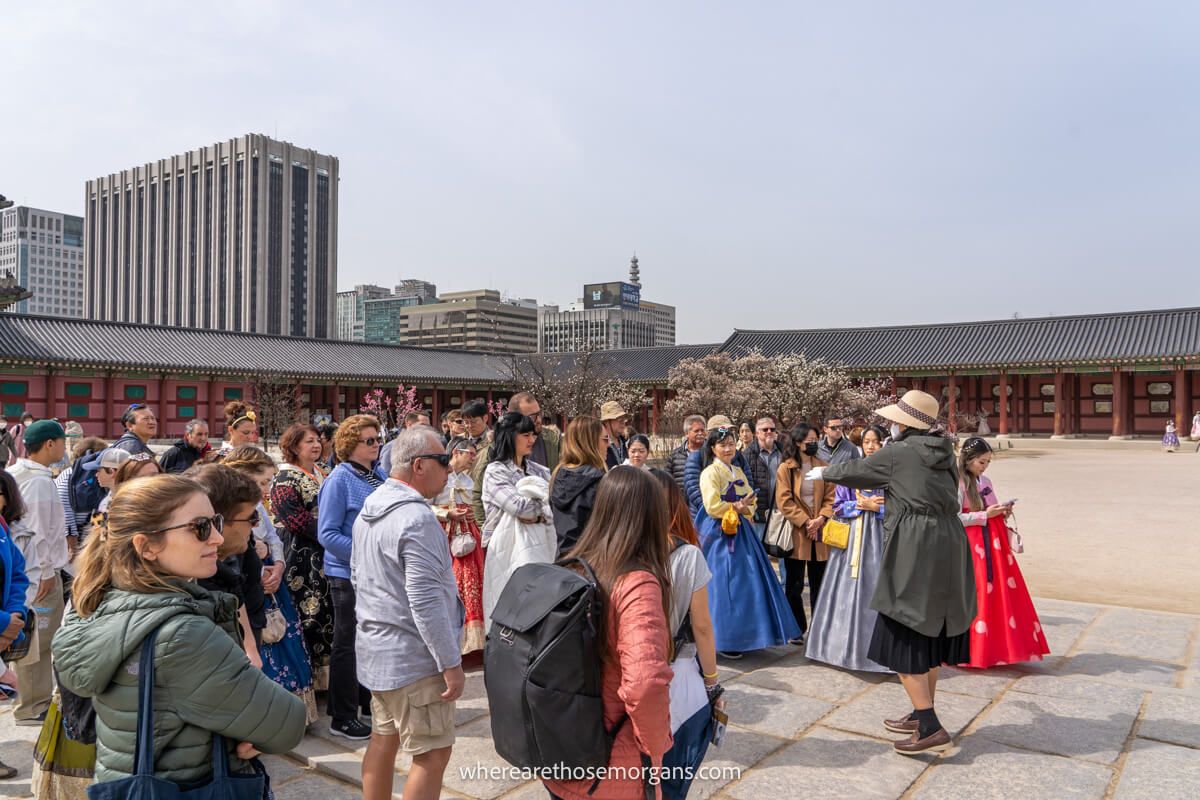
There are many ways you can experience Gyeongbokgung Palace. You can use the free informational brochures provided in numerous languages to walk around the grounds and learn about the various buildings on your own. Or you can rent an audioguide at the main entrance.
When we visited, we took the 11:00am free guided english tour provided on site and it was well worth our time. You can expect a tour to last between 60 and 90 minutes. The tours begin in front of information center inside the Heungnyemun Gate. Here are the guided tour times for the palace:
- Chinese: 10:30, 15:00 (Wed-Mon)
- English: 11:00, 13:30, 15:30 (Mon-Wed)
- Japanese: 10:00, 14:30 (Wed-Mon)
- Spanish: 10:30, 15:00 (Fri + Sat)
If you can’t visit during the free guided tour hours, you can book a tour with a third party company. Many of these tours include admission to the palace as well as some of the best things to do in Seoul.
Here are highly rated tours:
- Gyeongbokgung History Walking Tour – Two hour tour featuring the history of the Joseon Dynasty’s largest palace
- Seoul City Highlights + Palace Tour – Four hour tour with an optional hanbok experience
- Gyeongbokgung Morning Tour – A detailed tour with a local guide to help you lean about the best parts of the palace
- Walking Tour With Expert – Three hour tour featuring Gyeongbokgung Palace and Bukchon Hanok Village
10 Best Things To Do In Gyeongbokgung Palace
It can be very overwhelming when you visit Gyeongbokgung Palace because it’s such a large palace and one of Seoul’s main attractions. However, there are important highlights you shouldn’t miss during your visit. Here’s what to see at Gyeongbokgung Palace:
1. Changing Of The Guard
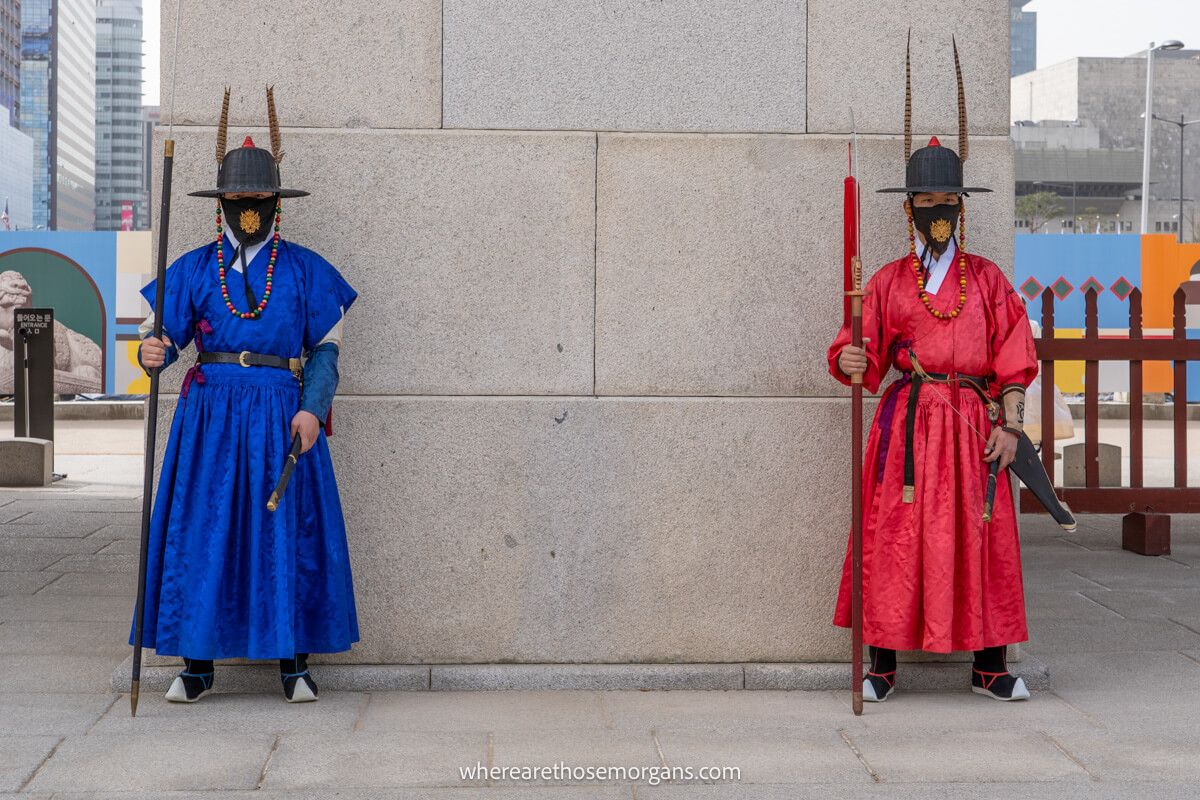
One of the best things to see at Gyeongbokgung Palace is the changing of the guard ceremony. There are two different ceremonies you can see and they take place at various times throughout the day either inside or outside the main gate of the palace.
The first is the guard duty performance which occurs outside of Gwanghwamun Gate and this ceremony takes place at 11:00 or 13:00. The second is the changing of the palace guard which happens inside Gwanghwamun Gate at 10:00 or 14:00.
If you’ve seen changing of the guard at Buckingham Palace in London, it’s very similar. We recommend you try to make it for at least one ceremony because they are performed extremely well and showcase an important part of Korean history.
Travel Tip: If you miss the changing of the guard ceremony at Gyeongbokgung, you can also see it at Deoksugung Palace in front of Daehanmun Gate at 11:00, 14:00 or 15:30.
2. Geunjeongjeon Hall
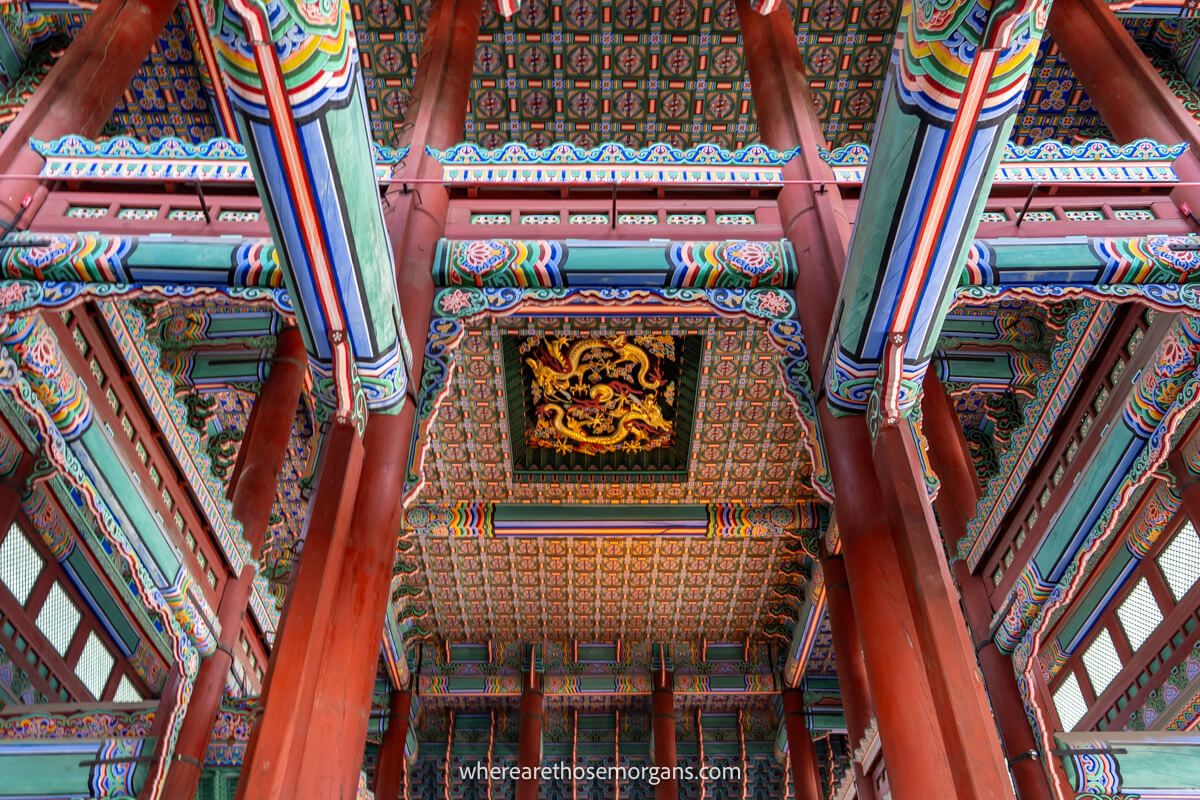
Built for the sovereignty of the Joseon rulers, Geunjeongjeon Hall was the throne hall of the palace. It held official events such as coronation ceremonies, cabinet meetings and receptions of foreign envoys. This hall is the largest and most formal hall in the entire complex so you shouldn’t miss it.
Throughout the years, seven of the twelve Joseon kings were enthroned at Geunjeongjeon Hall. This is also where high ranking officials were assembled to pay respect to the king. The original Geunjeongjeon Hall was built in 1394, but it was burnt down by the Japanese in 1592 and the building you can see today was rebuilt in 1867.
Travel Tip: This is one of the most crowded locations in the palace so if it’s busy continue with other buildings in the complex and return when the crowds subside.
3. Sujeongjeon Hall
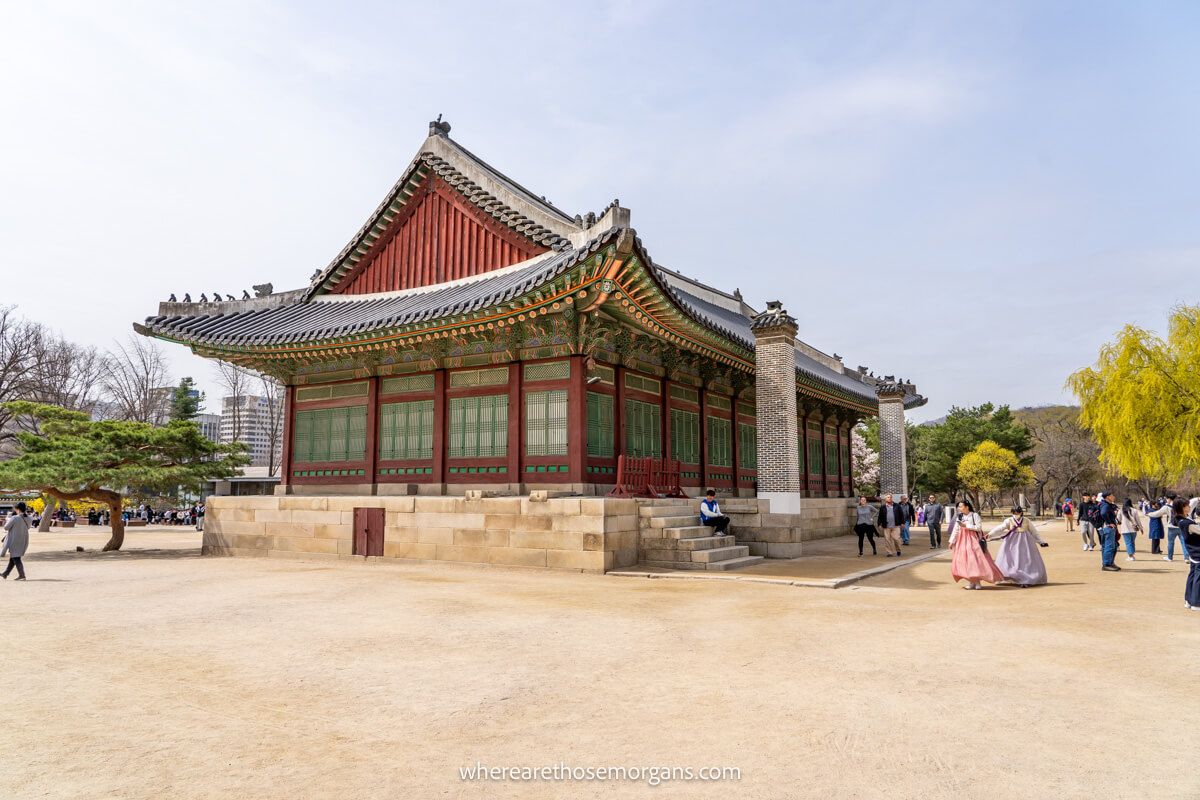
The Sujeongjeon Hall is the only surviving building of all the government offices. It principally served as a council hall where the king discussed national affairs with his court officials through morning briefings and royal functions.
During our tour, we learned this area once contained a building known as Jiphyeonjeon. This is where the Korean alphabet and writing system was invented during the reign of King Sejong (1418-1450). But the current hall we see today was built in 1867.
4. Gyeongheoru Pavilion
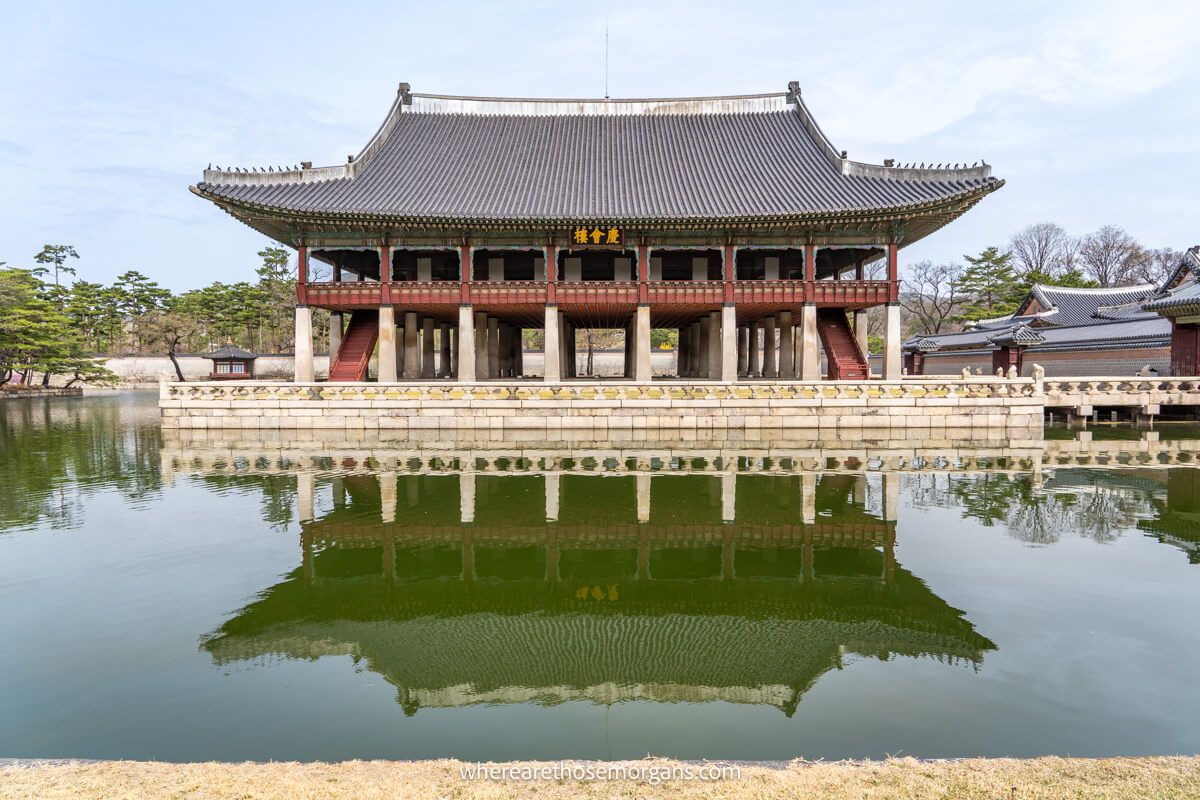
Located on an artifical lake, Gyeongheoru Pavilion can be found in the western part of the palace. The pavilion was used for royal banquets, large receptions, final state examinations and religious rituals. “Gyeonghoe” translates to a joyous banquet and the “-ru” suffix means pavilion.
Originally built as a small pavilion for the king to enjoy the views of Inwangsan Mountain, both the pond and pavilion were enlarged in 1412. But much like many of the other palace buildings, it was destroyed by fire in 1592 from the Japanese invasion and rebuilt in 1867.
Today, Gyeongheoru Pavilion is still in use for special functions and the second floor showcases a banquet hall. There are 48 high stone supports with 24 round and 24 square pillars.
Travel Tip: Gyeongheoru Pavilion is the largest elevated pavilion in Korea.
5. Sajeongjeon Hall
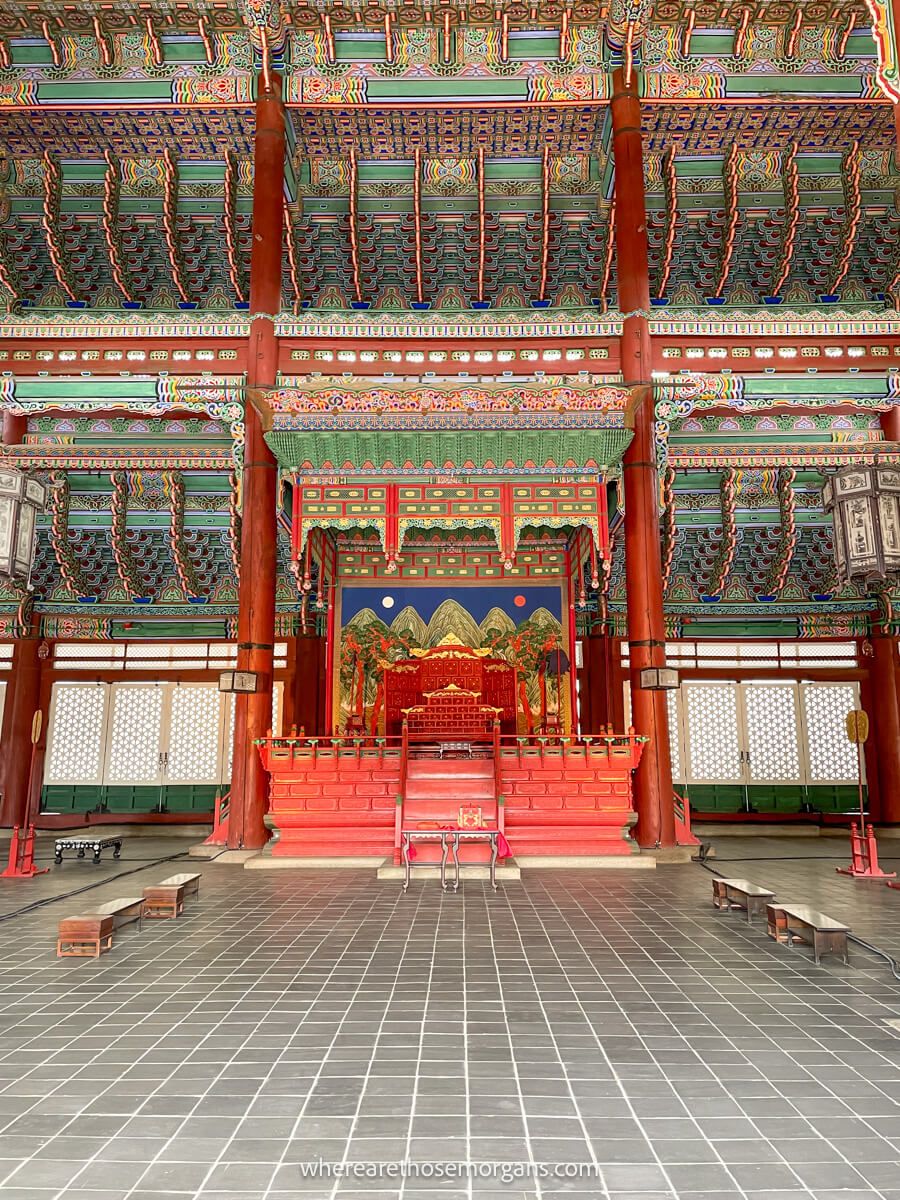
Another interesting building inside Gyeongbokgung Palace is Sajeongjeon Hall. This building served as council hall where the king could meet with high ranking officials, hold daily morning assemblies or attended lectures on state affairs. Rebuilt in 1867, you’ll also find a throne in this hall similar to Geunjeongjeon.
Travel Tip: The two auxiliary halls located on the right and left of Sajeongjeon Hall contain flues in the floors which were used for heating. It’s assumed these buildings were historically used in all four seasons.
6. Gangnyeongjeon Hall
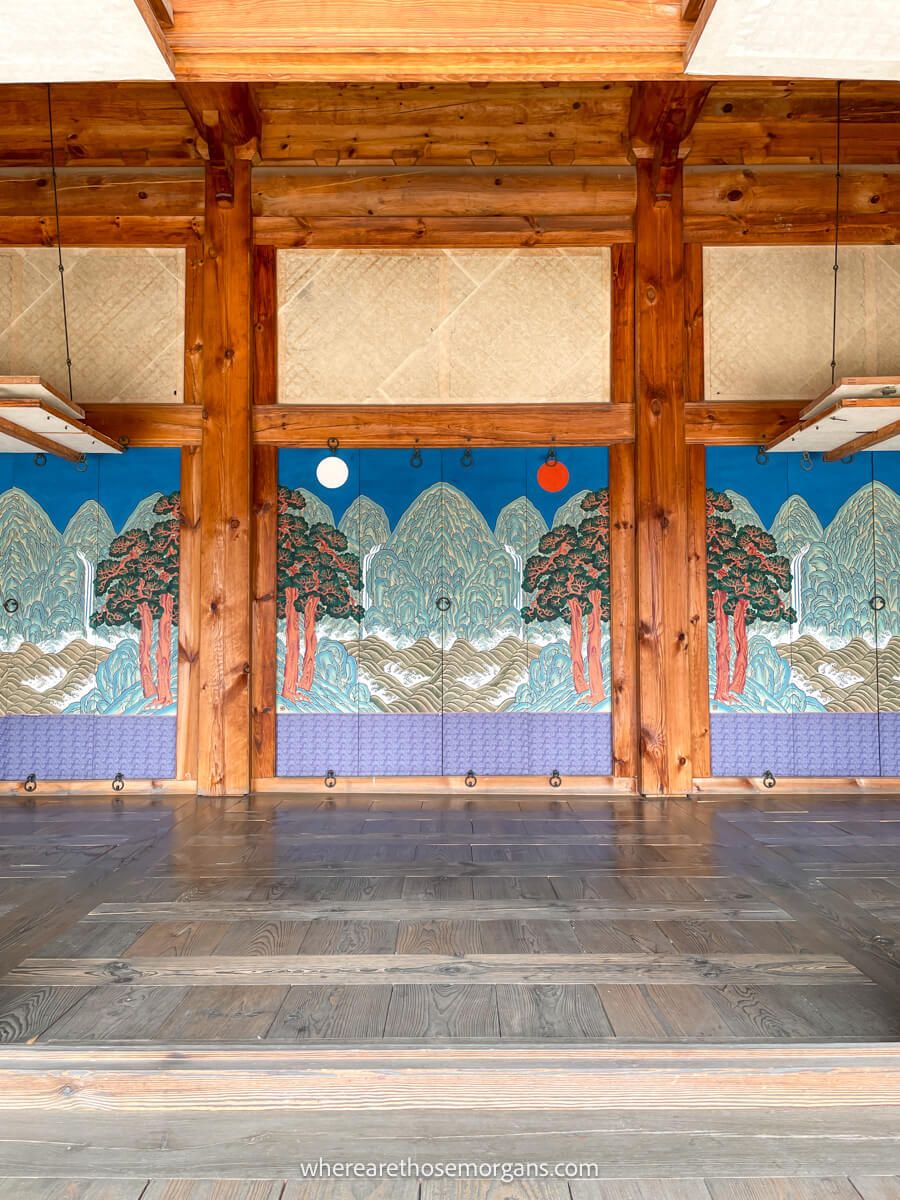
Located in a secluded part of the palace, Gangnyeongjeon Hall served as the main living quarters for the king and queen. There was a private area where the king slept, but it was also used for unofficial meetings, reading and refreshments when the king needed to secretly discuss issues.
The original Gangnyeongjeon Hall was burnt down in the Japanese invasion in 1592 and it was restored in 1865. But the new building was dismantled in 1917 and taken to Changdeokgung Palace after a fire. The Gangnyeongjeon Hall we see today was restored in 1995.
7. Gyotaejeon Hall
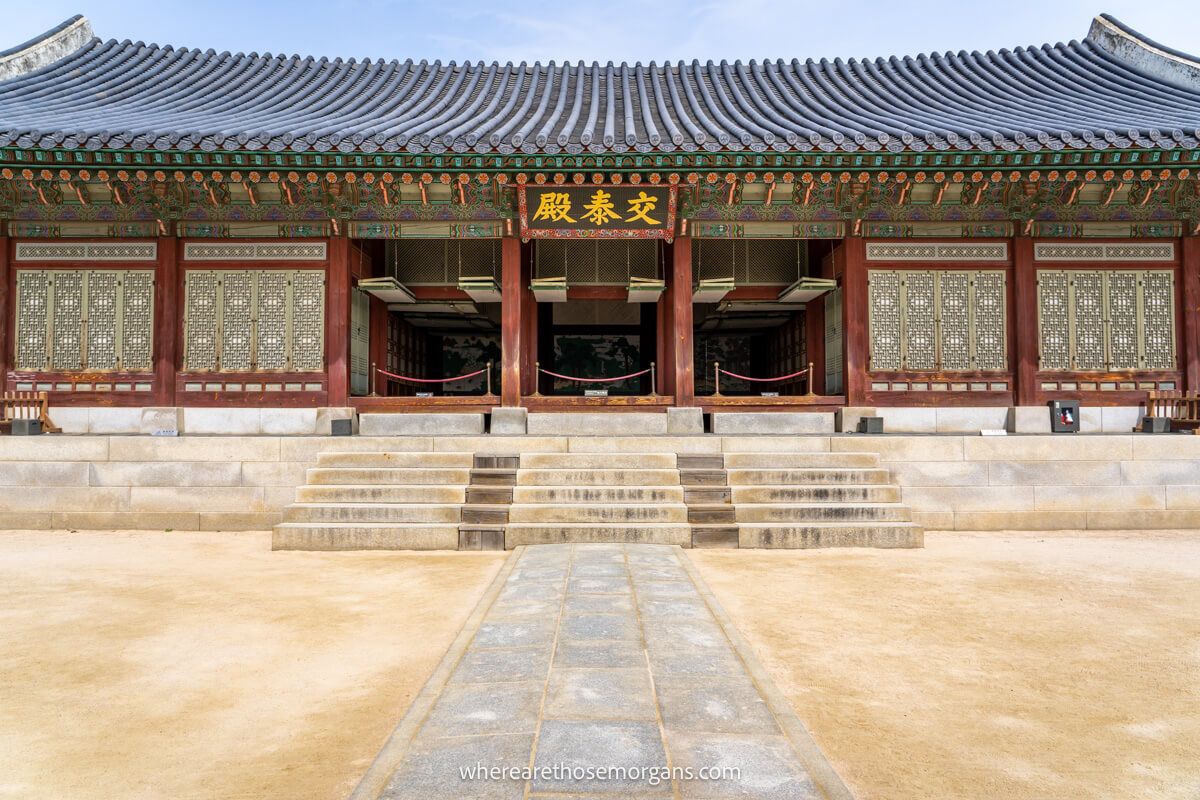
Along with Gangnyeongjeon Hall, Gyotaejeon Hall was the official residence of Joseon queen consorts. Their main duties included managing and supervising the royal household affairs with all members of the female royal court. It’s believed this hall was built around 1440 during King Sejong’s reign.
8. Amisan Mound
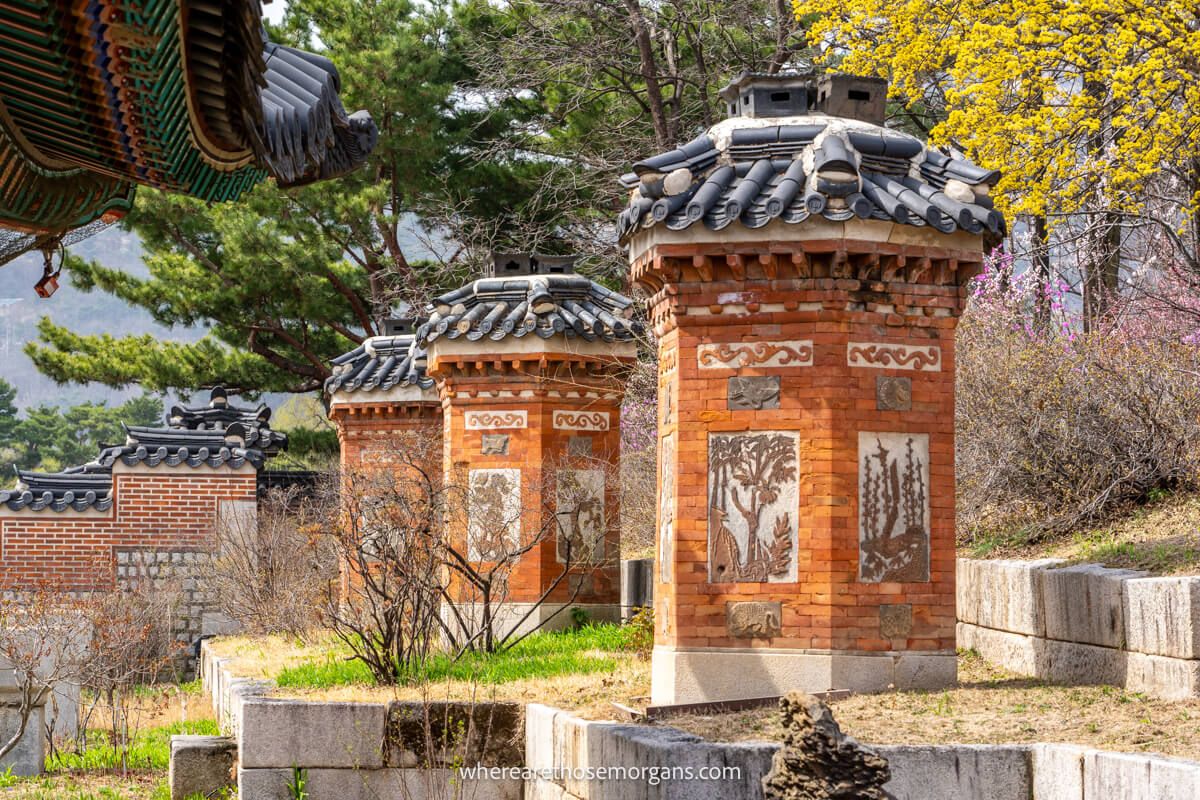
Just behind the Gyotaejeon Hall, visitors will find the beautiful Amisan Garden. The highlights of this garden are the four brick chimneys and the surrounding fine terraced flower beds. The four chimneys are hexagonal shaped and decorated with plants as well as the ten symbols of longevity to ward off evil spirits.
Travel Tip: We think Amisan Garden is a hidden gem inside Gyeongbokgung Palace so be sure you don’t miss it.
9. Hyangwonjeong Pavilion
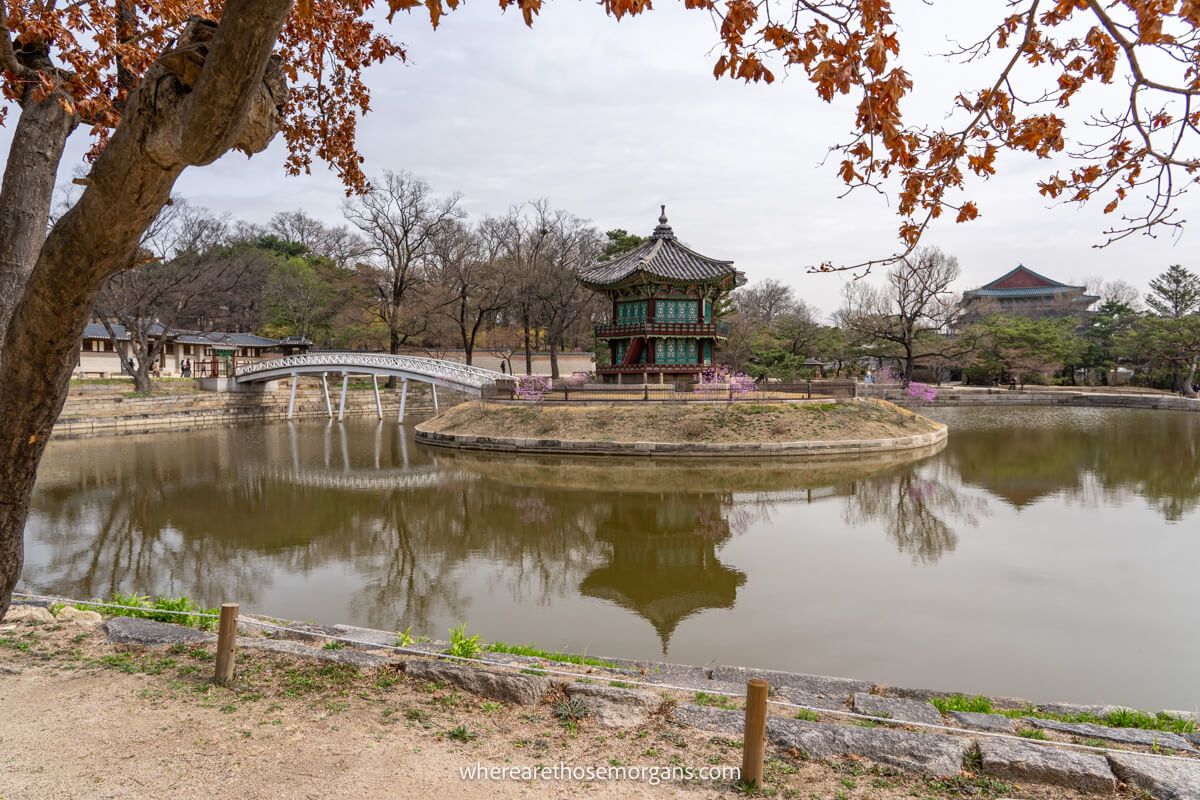
Created in 1456, the Hyangwonji Pond is found in the northern garden of Gyeongbokgung Palace. Hyangwonjeong Pavilion is a stunning structure that sits on top of an artificial island in the center of the pond.
We learned the beautiful wooden bridge leading to the pavilion is called the Chwihyanggyo Bridge and it literally translates to “getting intoxicated by the scent.” Unfortunately, visitors are not allowed to cross the bridge, but you’ll find carp and lotus flowers surrounding the pavilion.
Travel Tip: One of the most popular times to visit the Hyangwonjeong Pavilion is in spring or fall when vibrant foliage is reflected in the water of Hyangwonji Pond.
10. National Folk Museum Of Korea
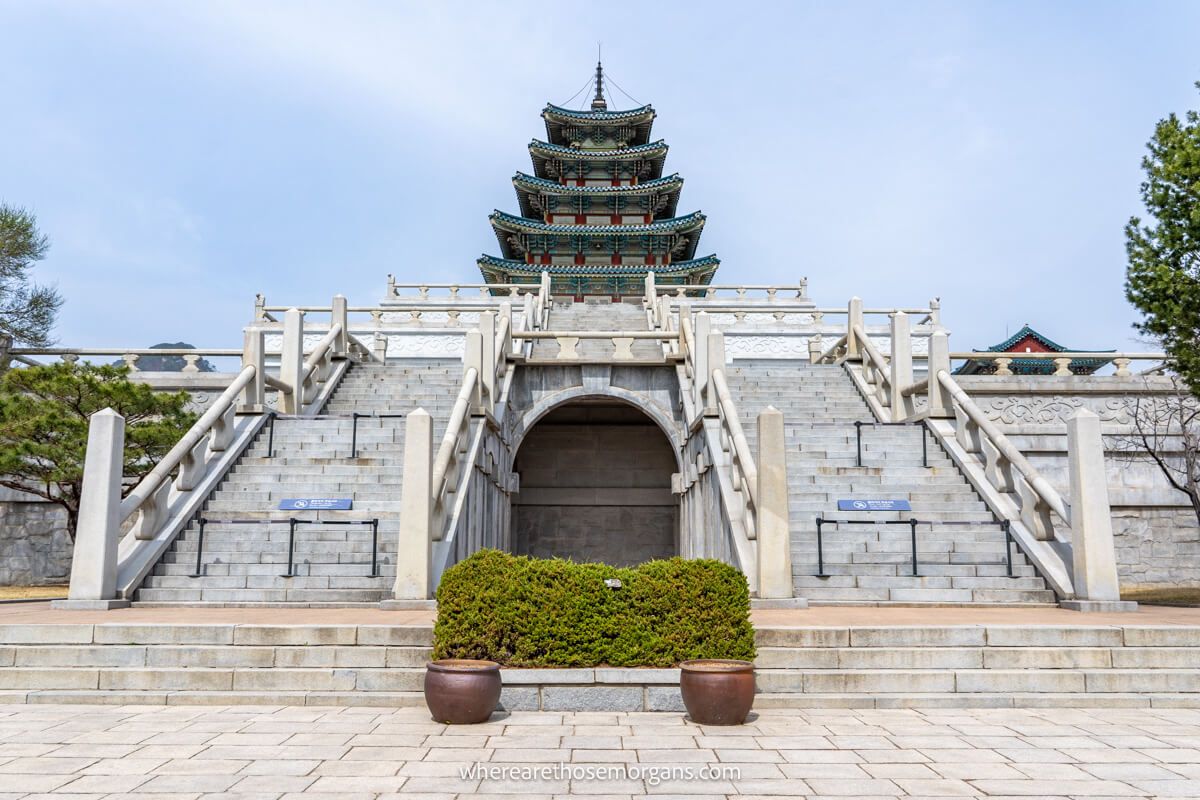
Technically not inside the palace, but located just outside on the eastern border is the National Folk Museum of Korea. It’s a popular museum that showcases the lifestyles, traditions and history of Korean culture.
The entire complex features three permanent exhibits along with two special exhibits, an open air exhibition and a children’s museum. Admission to the National Folk Museum of Korea is free with a Gyeongbokgung Palace ticket. You can join a free guided tour at 10:30 and 14:30 in front of Exhibition Hall 1.
The Morgan Conclusion
Visiting Gyeongbokgung Palace is one of the best things you can do in Seoul because it was the main palace of the Joseon Dynasty. While much of the palace was destroyed by Japanese invasions, extensive restorations have rebuilt many of the original buildings. Visitors can also take advantage of the free guided tours offered in numerous languages.
So is Gyeongbokgung Palace worth visiting?
Yes, the Gyeongbokgung Palace is worth visiting because it’s the largest palace in Seoul. You’ll be able to see where the kings and queens once lived including where they performed daily activities. Additionally, visitors can see the changing of the guard ceremony which is unique.
We think Gyeongbokgung is the most impressive palace in Seoul because it showcases hundreds of years of Korean history. The stunning architecture, expansive grounds and reenactments of royal rituals make it the most popular tourist attraction in city.
However, this is a very large complex and it will be very busy. You can also expect to walk a lot if you want to see the highlights we included in this guide. We spent about 3.5 hours inside Gyeongbokgung including our guided tour and watching the changing of the guard ceremony.
But you can shorten this time frame by visiting on your own. Of if you want to get away from the crowds, we suggest you visit Changgyeonggung or Deoksugung.
Our Gyeongbokgung Palace Photos
We enjoyed our visit to the palace and took many photos. Here are a few of our favorites so you know exactly what to expect:
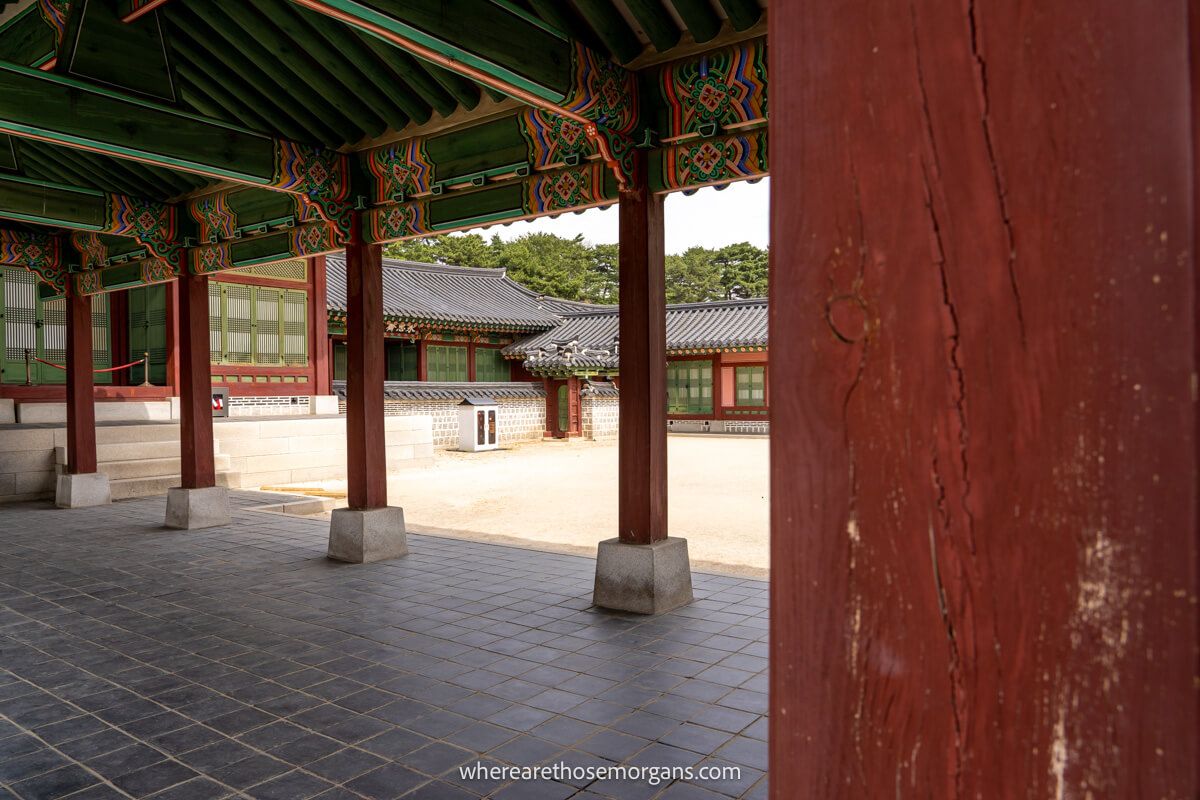
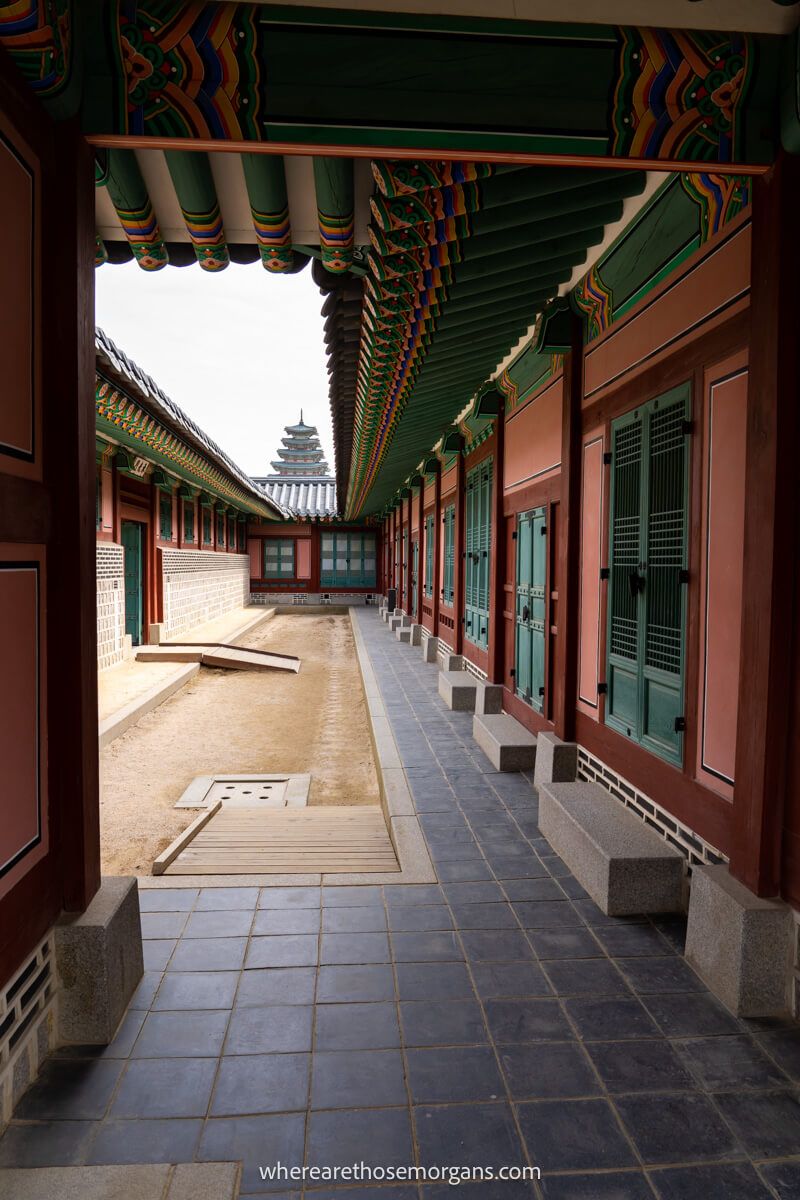
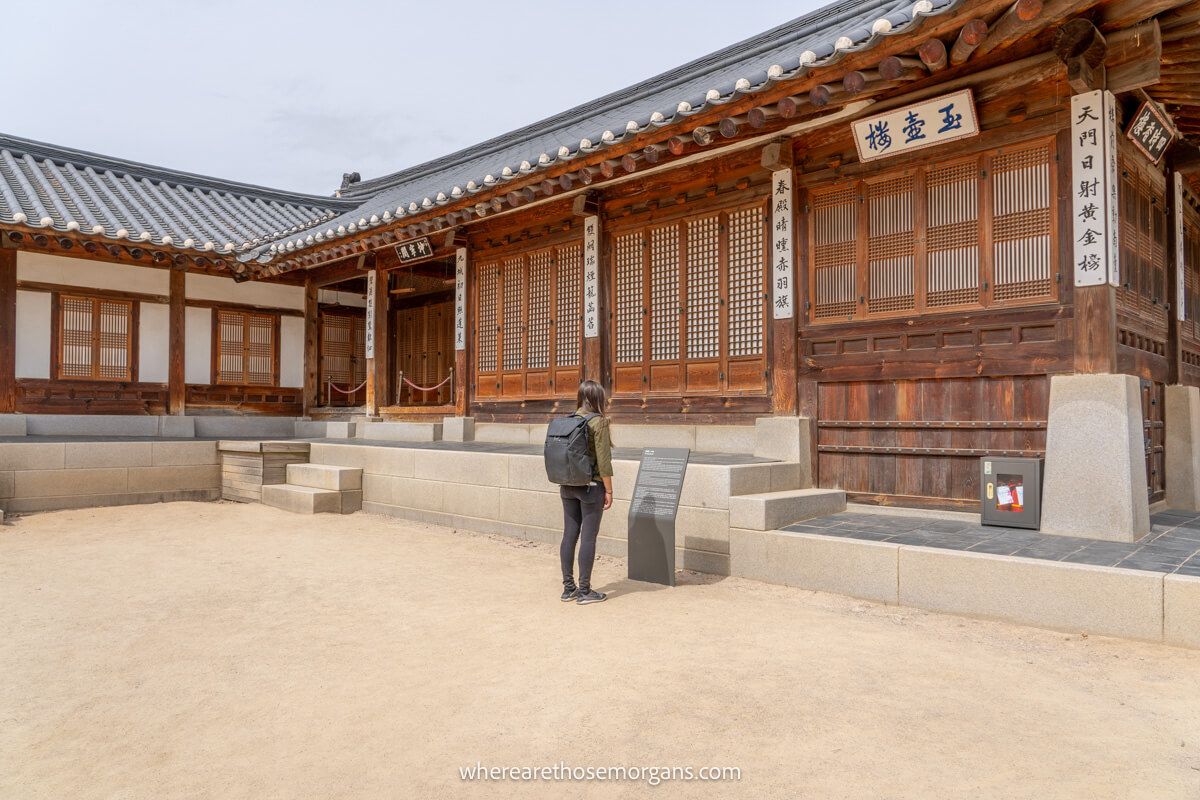
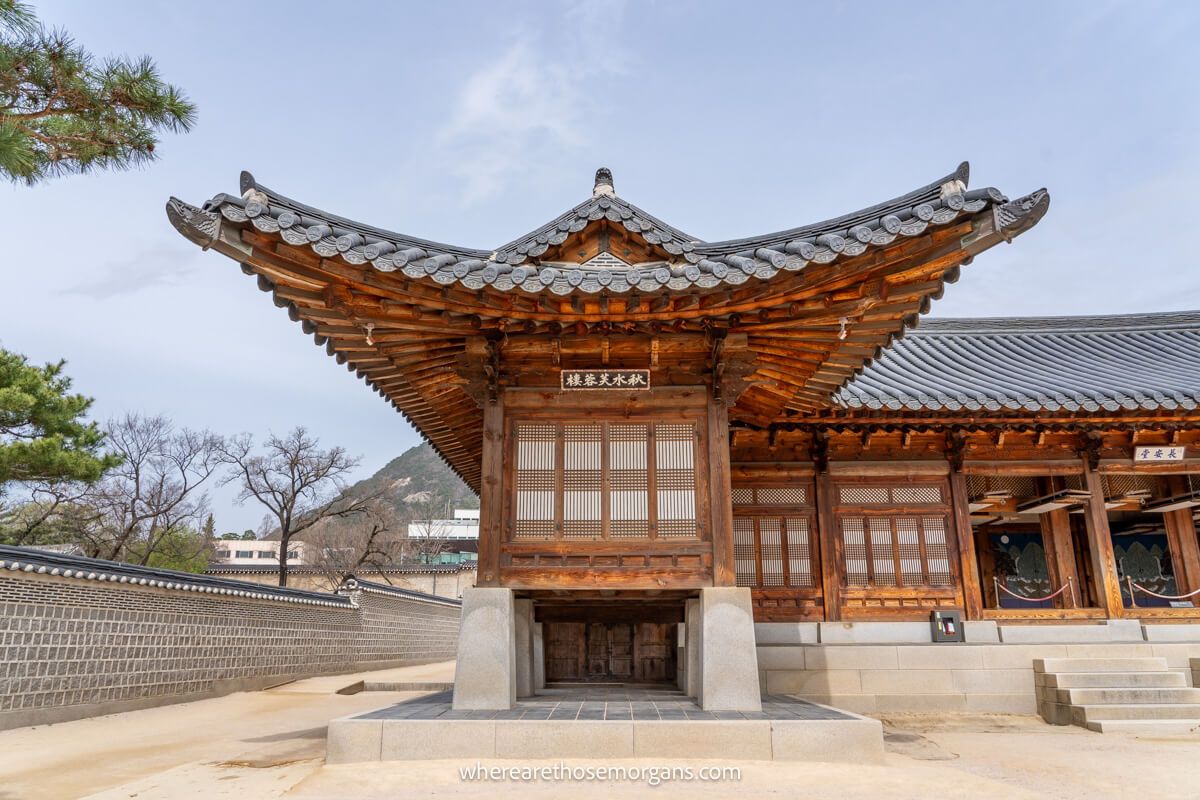
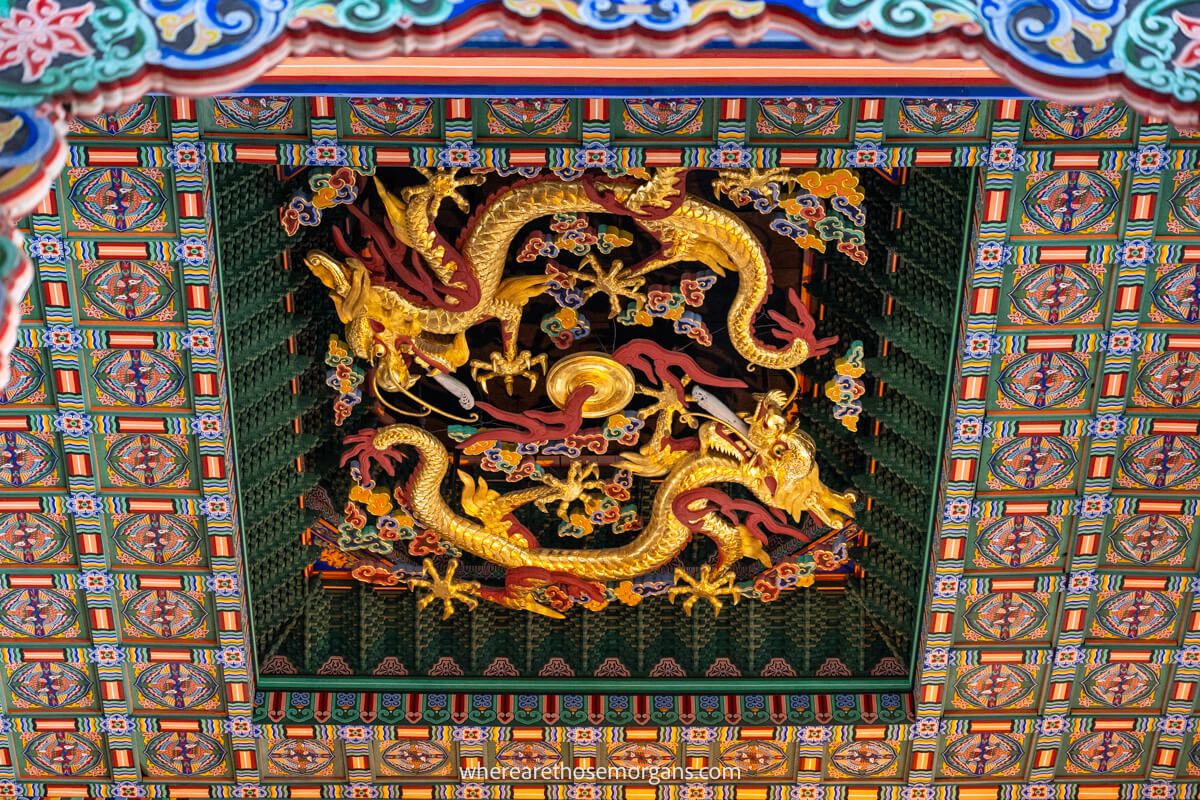
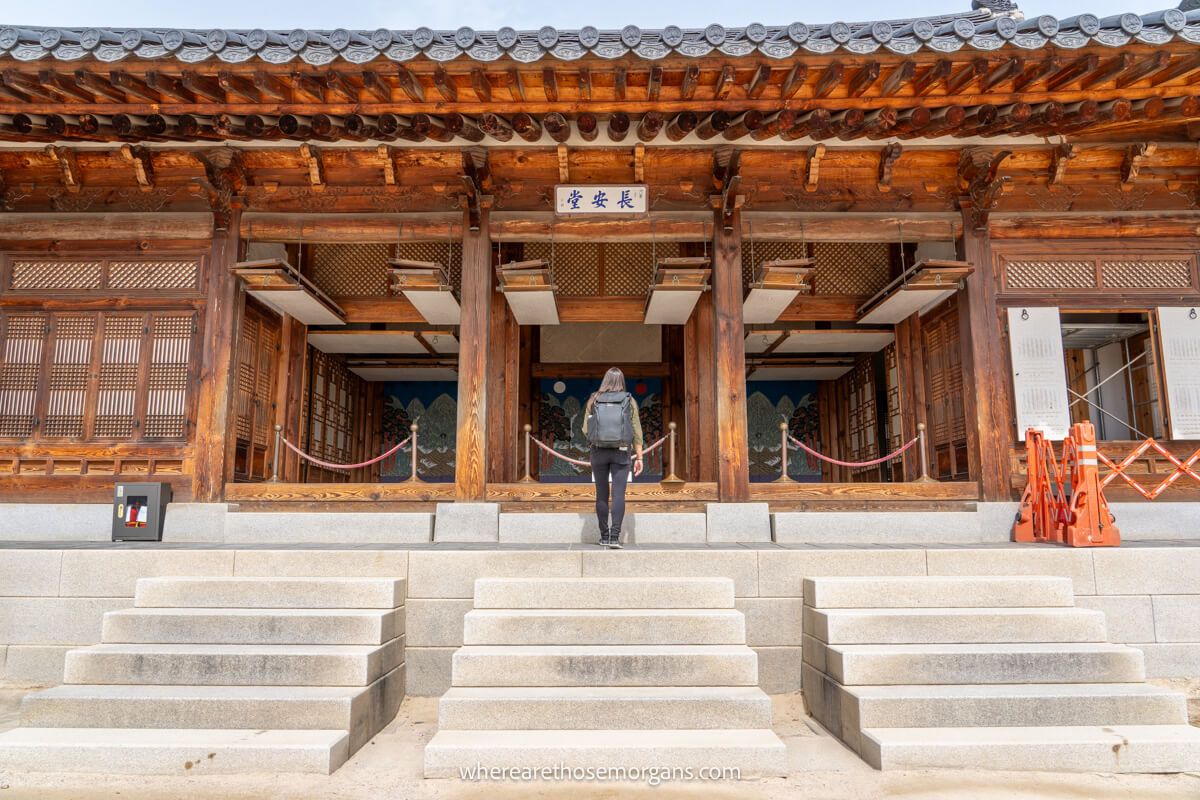
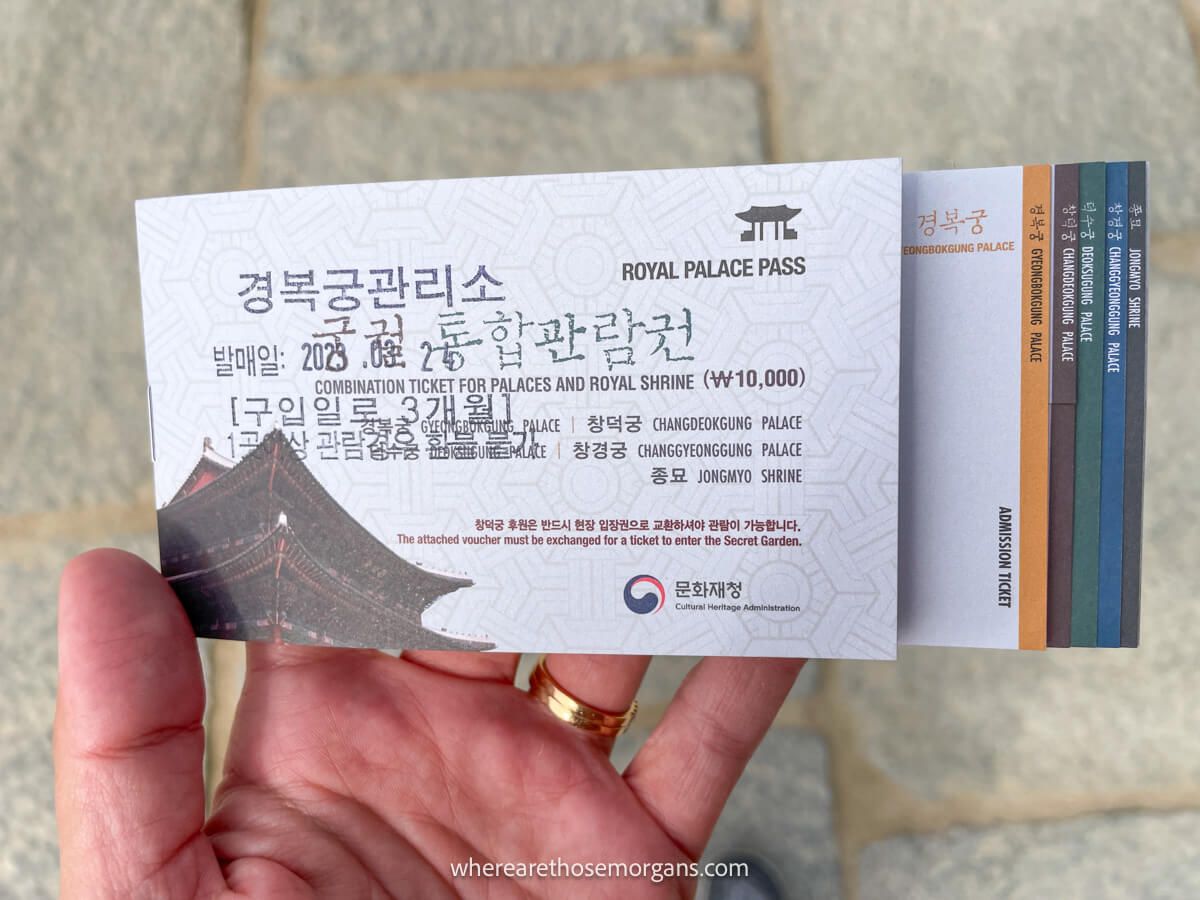
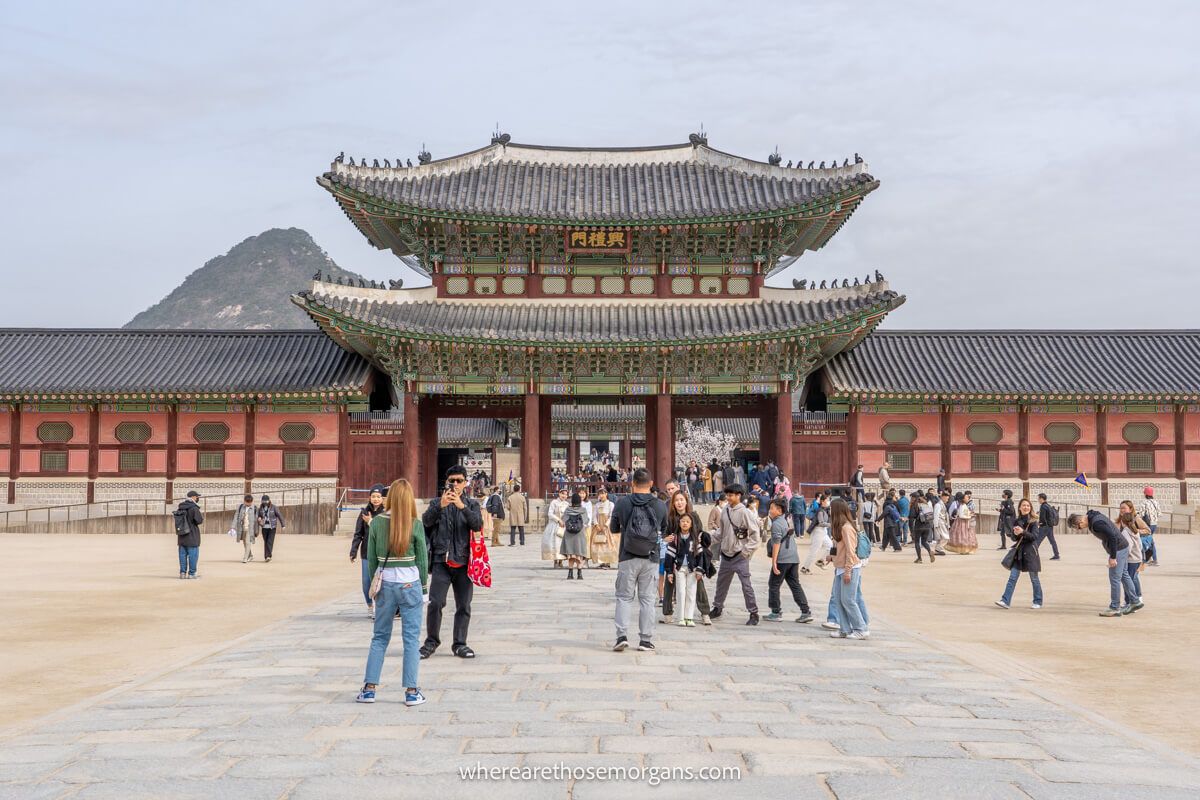
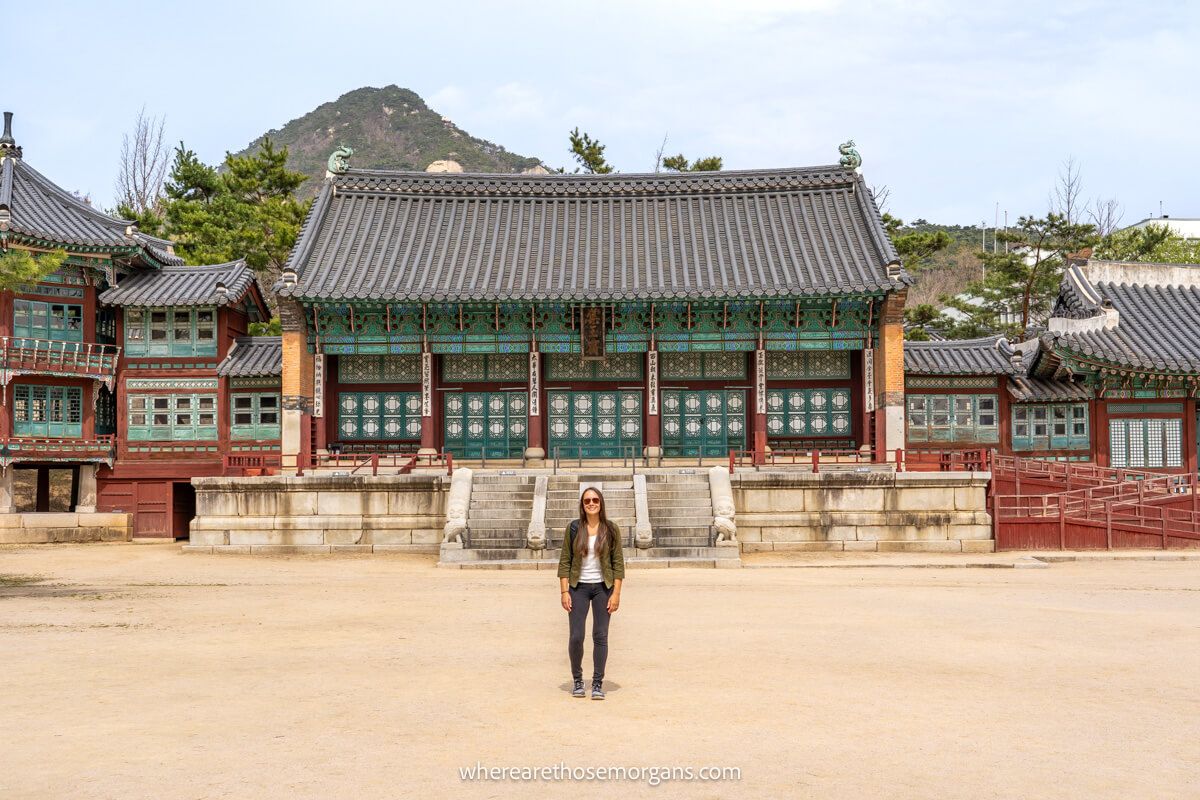

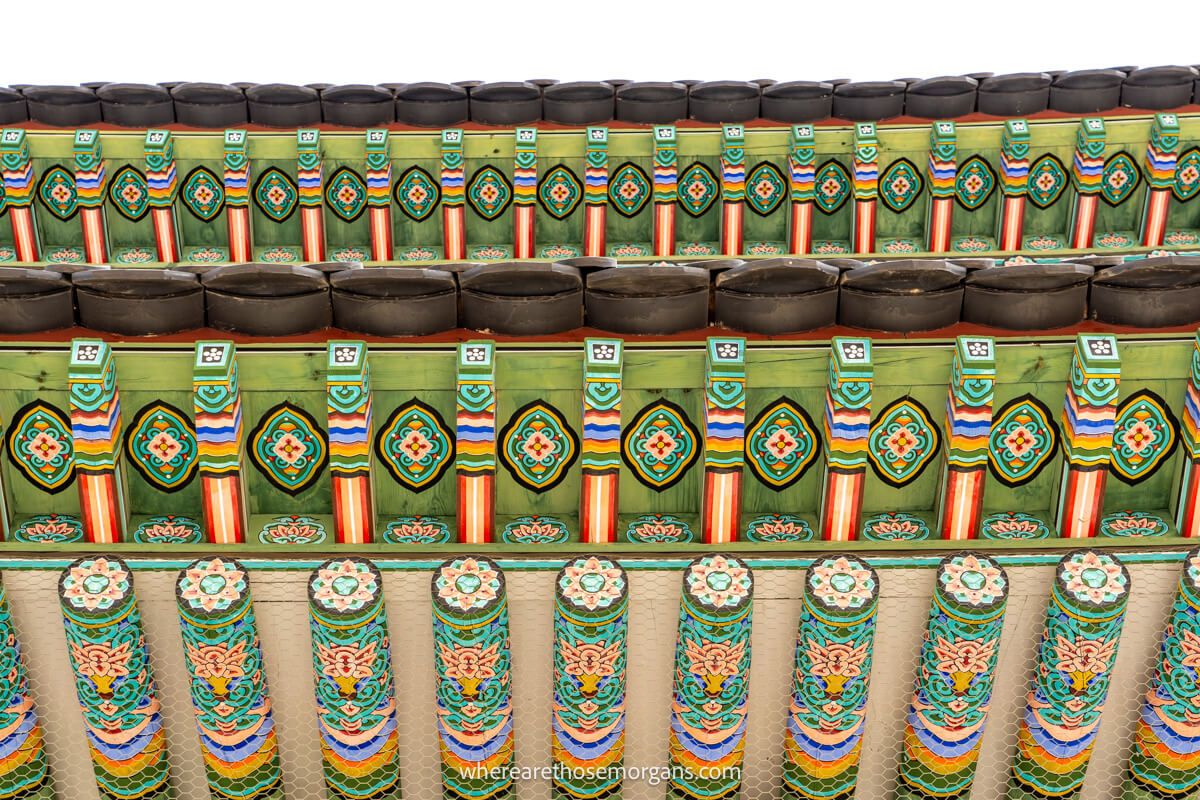
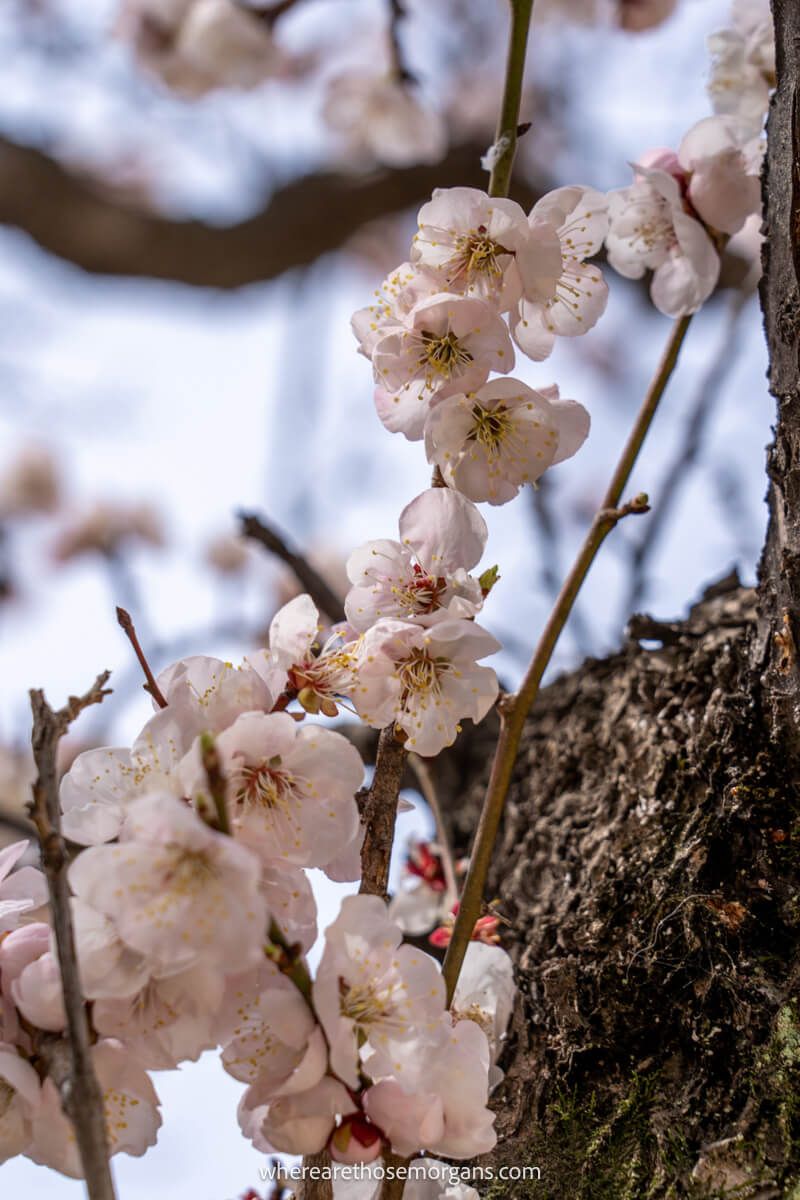
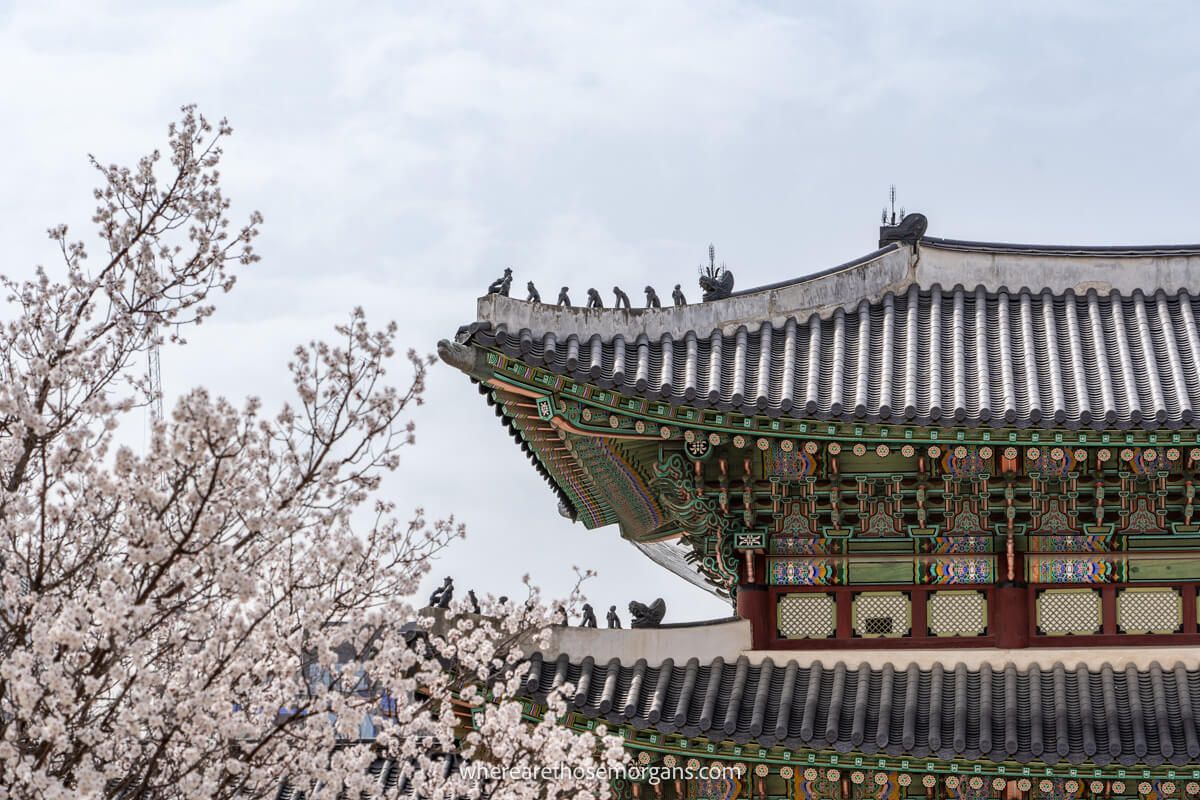
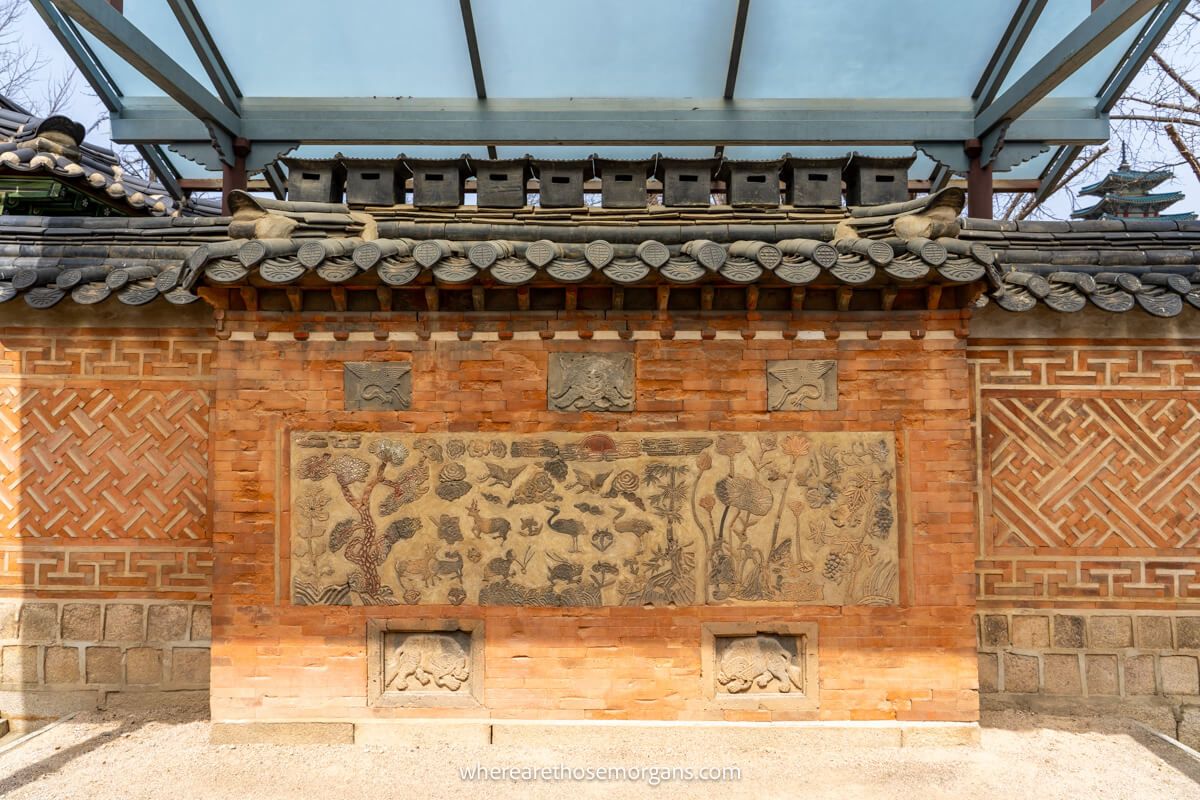
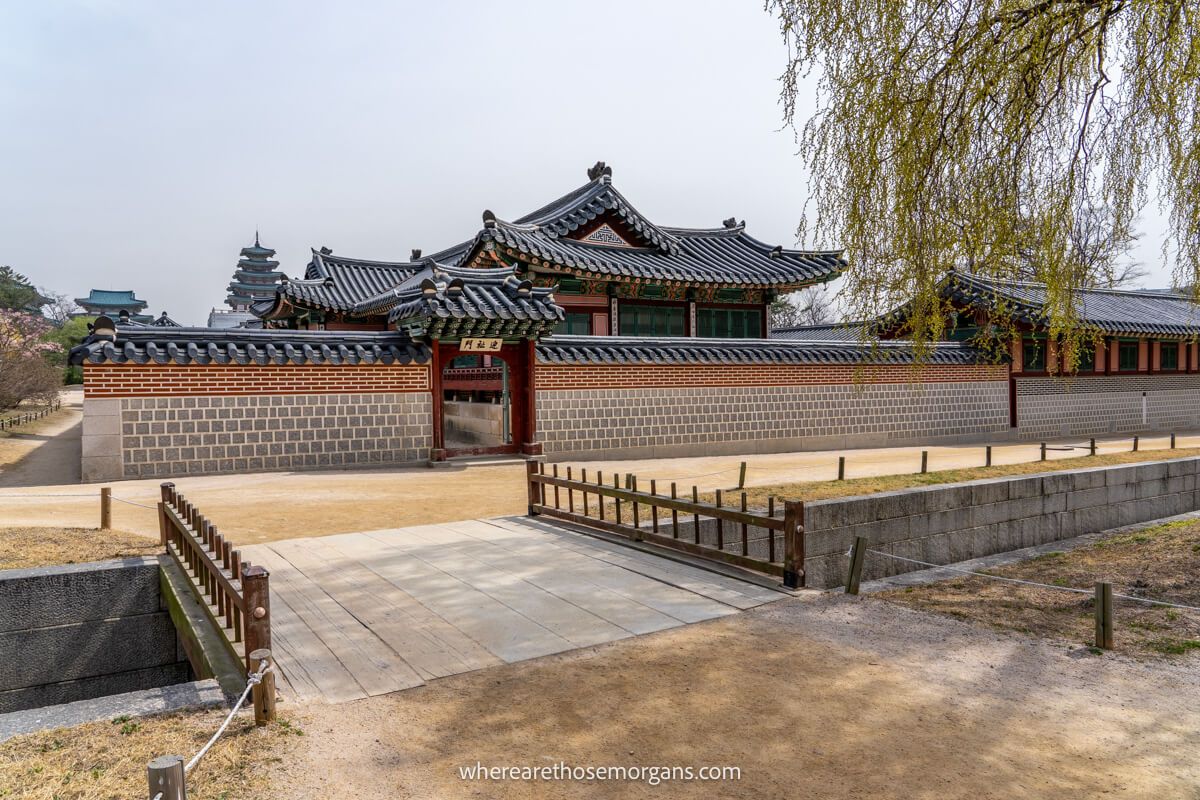
More Seoul Palaces
- How to visit Changdeokgung Palace
- What to see inside Huwon Secret Garden
- Guide to visiting Changgyeonggung Palace
- First time visitor guide to Deoksugung Palace
- Best things to see inside Gyeonghuigung
- The best palaces to visit in Seoul
Our Popular Seoul Guides
- 35 amazing things to do in Seoul
- How to find the best DMZ Tour
- Unique things to do at Imjingak Park
- How to visit the Namsan Seoul Tower
- Complete guide to Seoul Sky observatory
- How to visit the Jongmyo Shrine
- What to see at the Seodaemun Prison
- 20 best hotels in Seoul
Want more Seoul content? Head over to our South Korea Travel Guides to explore the very best of Seoul and beyond.
We hope this guide featuring best things to do at Gyeongbokgung Palace helps with planning your visit to Seoul!
Please let us know if you have any questions about visiting this palace or Seoul in the comments below.
Happy Travels,
Mark and Kristen
Enjoy this Gyeongbokgung Palace guide? Pin it for your visit!
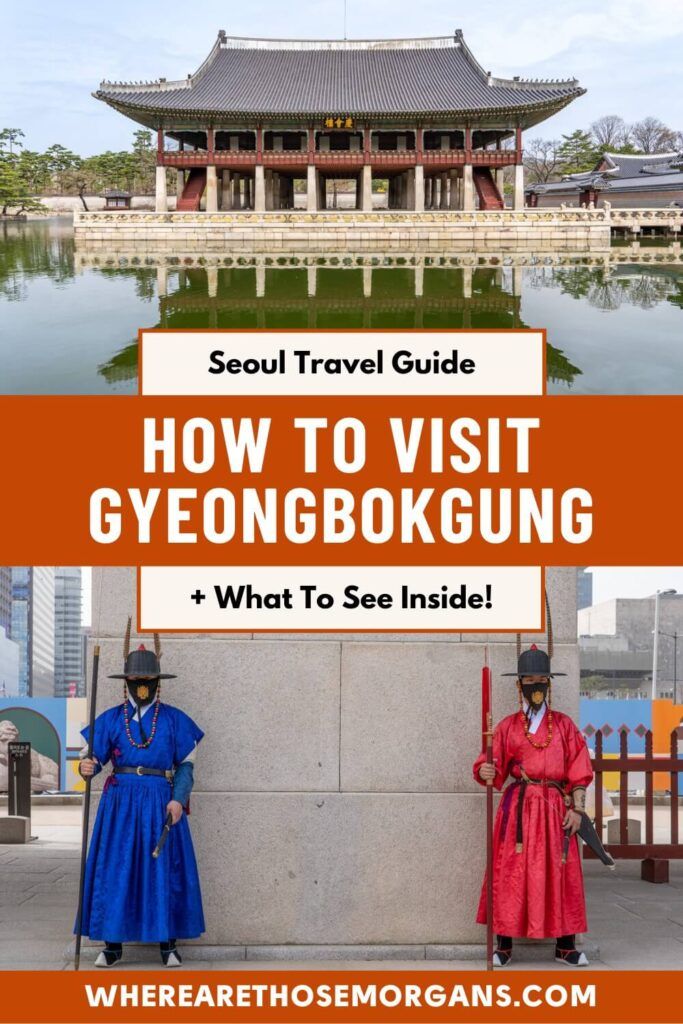
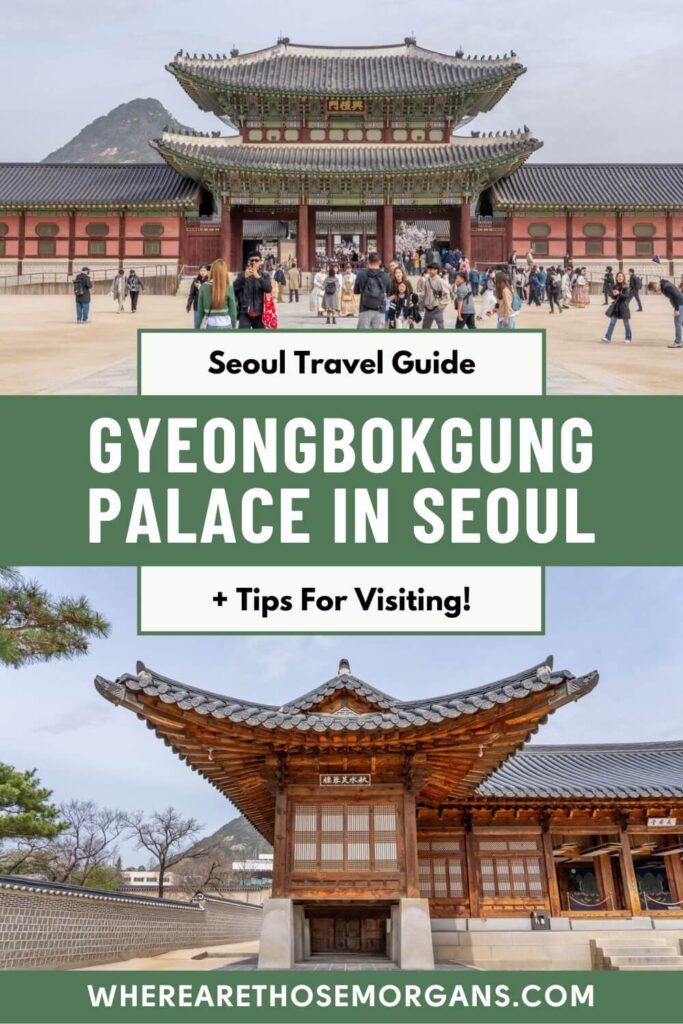
Note: This article contains affiliate links. When you make a purchase using one of these affiliate links, we may earn a small commission at no extra cost to you.
All Rights Reserved © Where Are Those Morgans, LLC. Republishing this article and/or any of its contents (text, photography, maps, graphics, etc.) in whole or in part is strictly prohibited.
Mark and Kristen Morgan are travel, hiking and photography experts. Over the last 6 years traveling full time, they have explored more than 40 countries and 30 US states.
Where Are Those Morgans has been featured in USA Today, Gestalten, Get Your Guide, CityPASS and Condé Nast Traveler along with various other publications. Read more about us.

